100% Stacked Area Chart
The 100% Stacked Area Chart allows for the comparison of multiple measures through the use of filled curves that are stacked vertically, one after another.
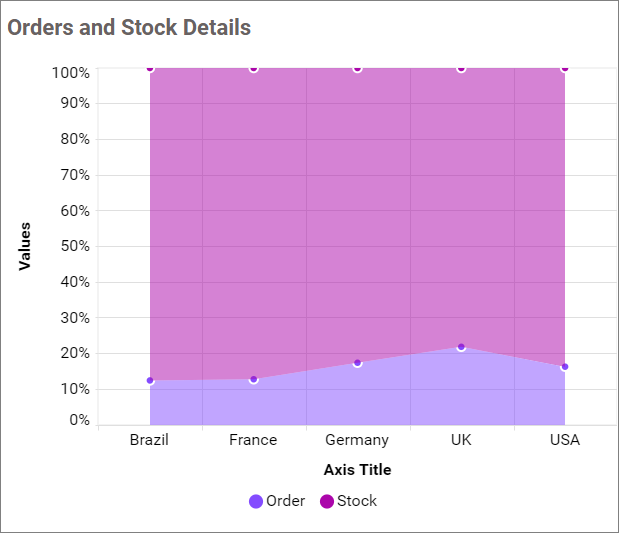
How to configure the table data to 100% stacked area chart?
A 100% Stacked Area Chart requires at least one value element and one column element to display. The measure or expression field that you want to analyze can be placed in the Y Values block. The dimension that you want to categorize the measure by can be placed in the Columns block. If you want to categorize based on a series, you can also place the respective dimension in the Rows block.
To configure the data to a 100% stacked area chart, follow the steps below:
- Drag and drop the 100% stacked area chart onto the canvas and resize it according to your desired size.
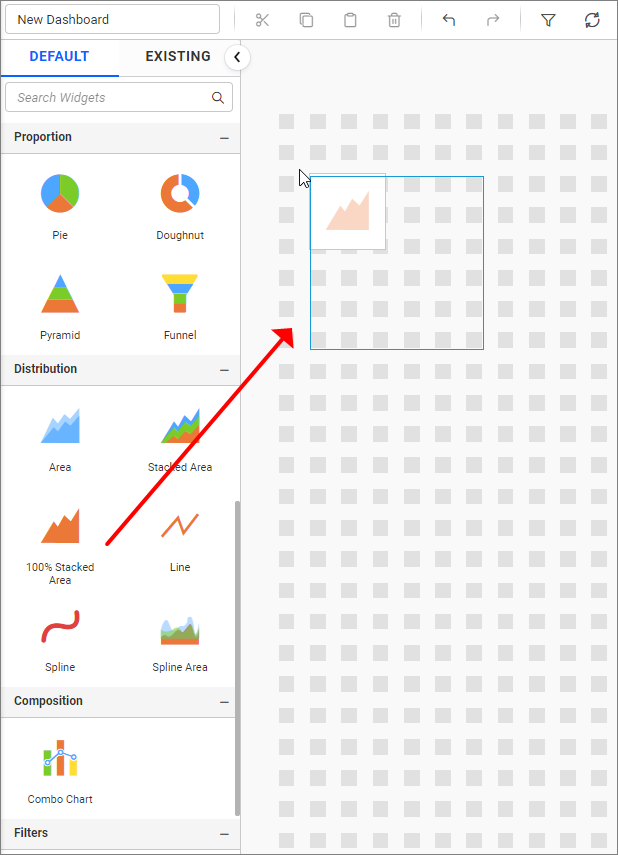
- Click the
Data Sourcebutton in the configuration panel.
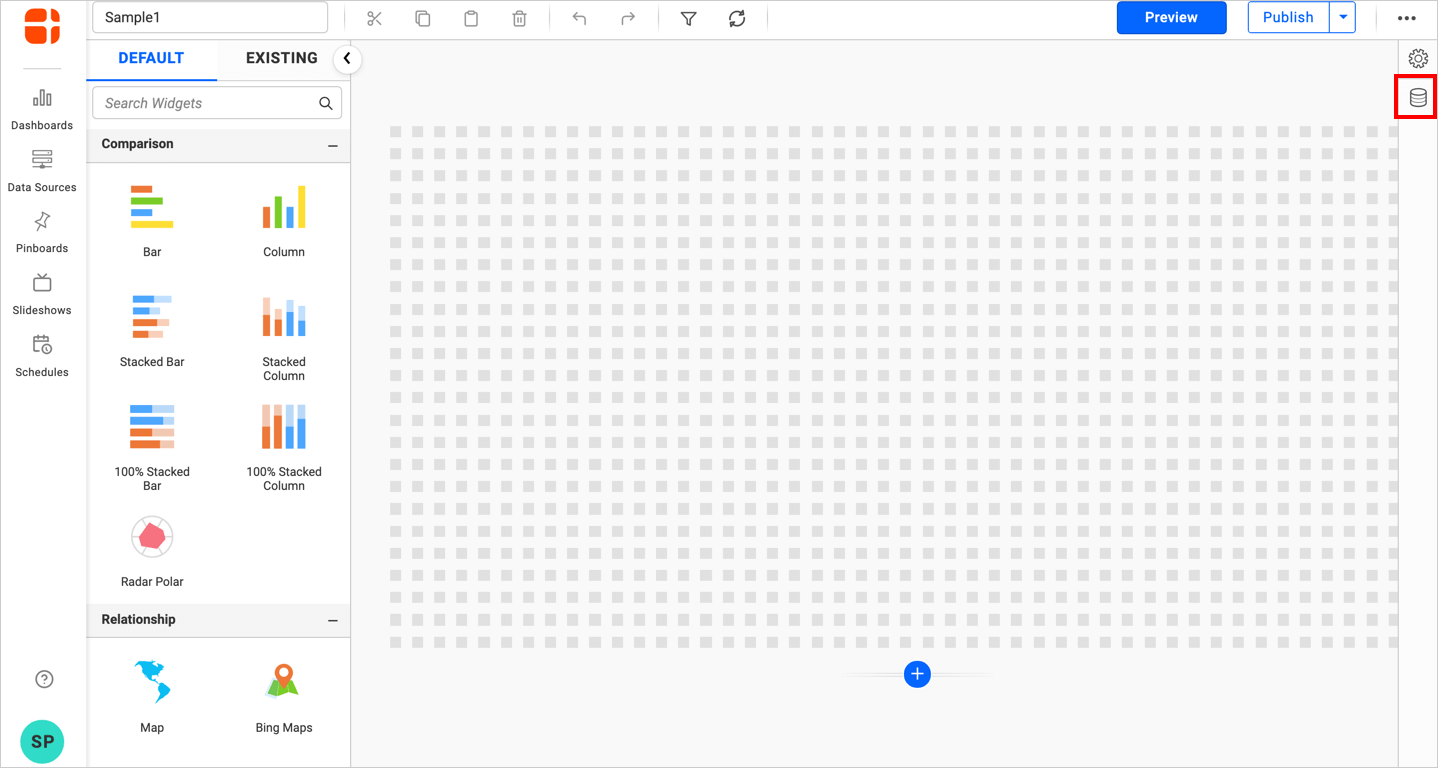
- Click the
CREATE NEWbutton to initiate a new connection from the connection type panel.

- In the connection type panel, click on any one of the listed connection type buttons (Here, the
Microsoft ExcelConnection type is selected for demonstration).

- In the
NEW DATA SOURCEconfiguration panel, fill out the connection type and related details. Click theConnectbutton.
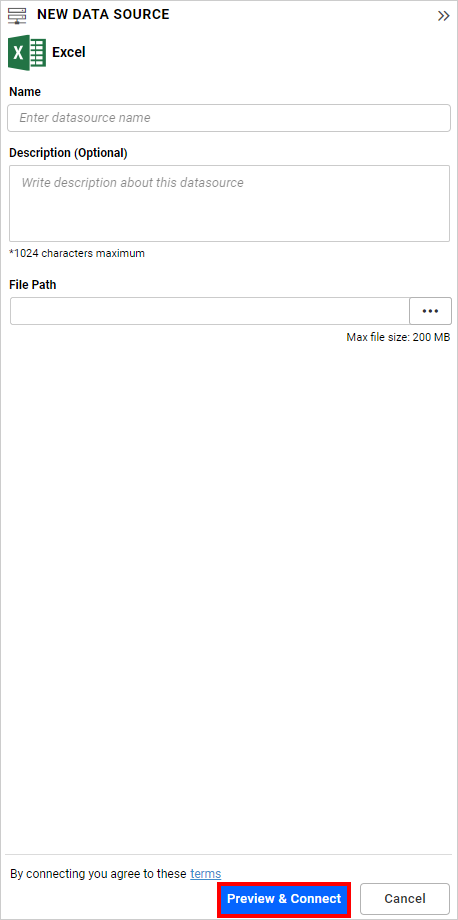
- Drag your preferred table or view from the left pane in the data design view, then click the
Savebutton.

- Click the
Propertiesbutton in the configuration panel, and the property pane will open. Now, switch to theASSIGN DATAtab.
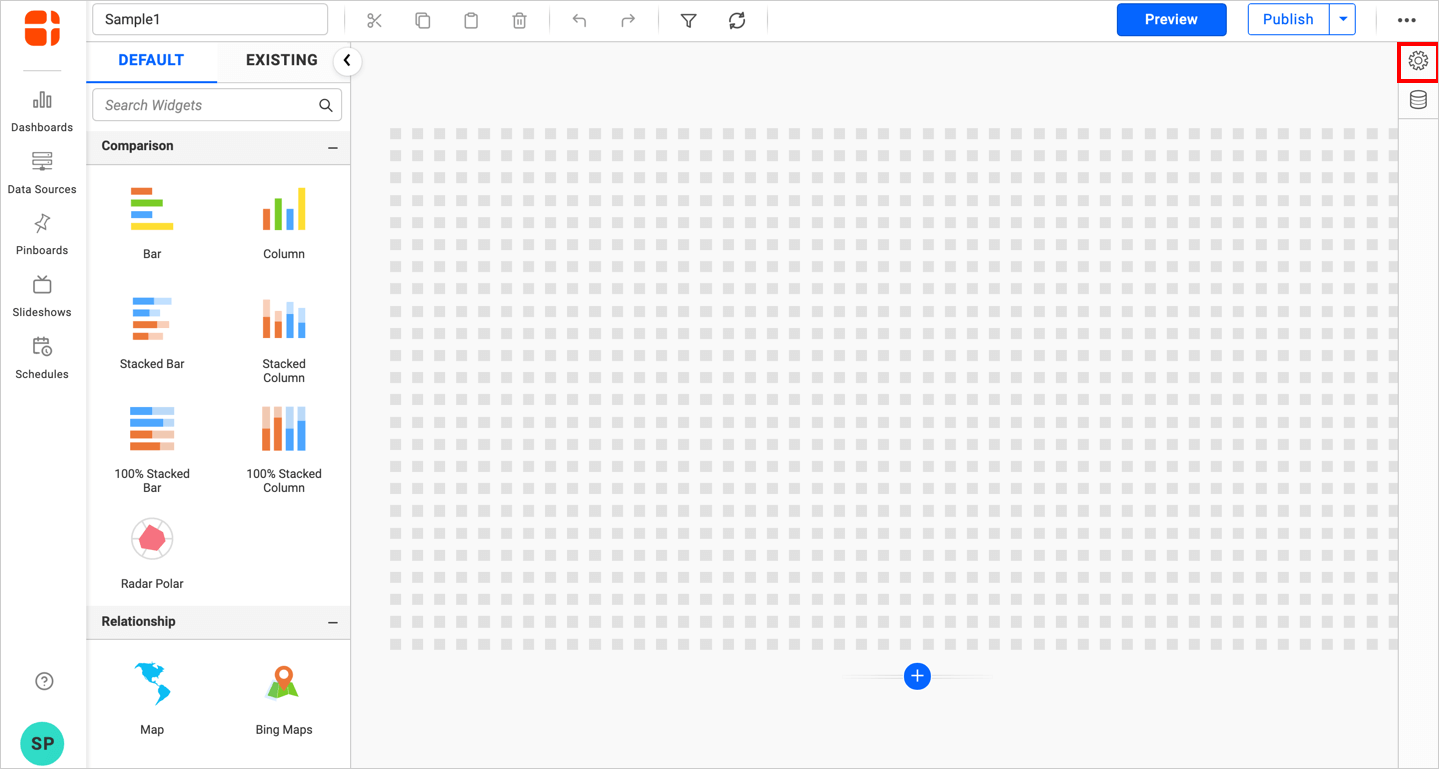
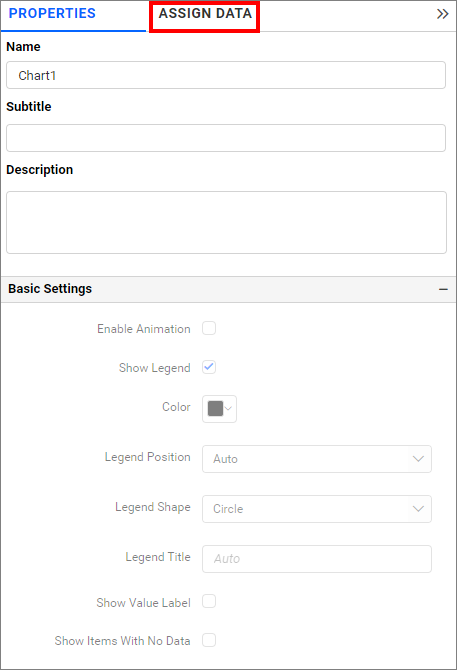
- The
ASSIGN DATAtab will be opened, displaying the available measures and dimensions from the connected data source.
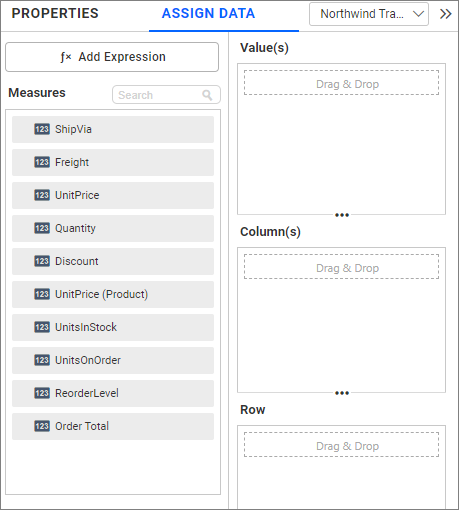
- You can add the necessary data from the
MeasuresandDimensionsinto the designated field.
Adding Value(s)
You can add more than one Measures into the Value(s) field by dragging and dropping the required measure.

Click on the Settings option to change the required summary type from the available summary types shown in the Settings section.

Filtering data
You can filter the data that is displayed in a chart by using the filter option. For more details, refer to the filter.
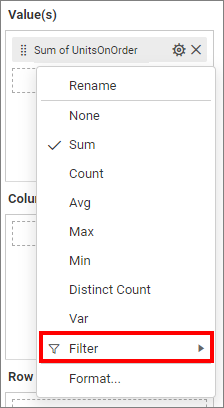
Formatting data
You can format the data to be displayed in a chart by using the format option. For more details, please refer to the measure format.
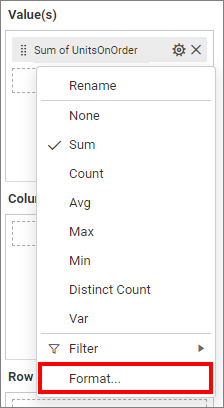
To remove the added value fields, click the highlighted button.
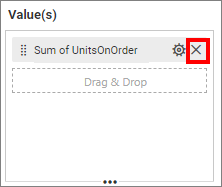
You can add multiple columns from the Dimensions field to the Values field.
Adding Columns
You can add more than one value to the Columns field.

The chart will be rendered like this.
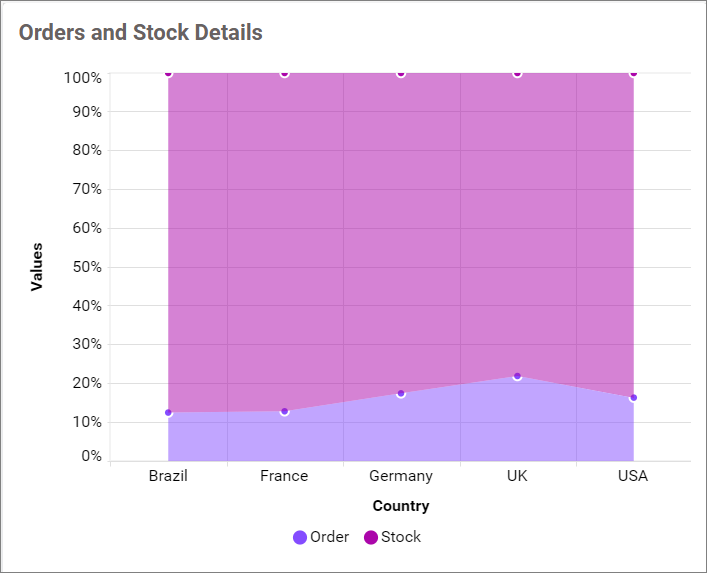
You can change the settings.
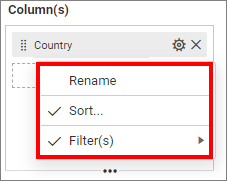
Renaming fields
The field names that have been configured can be edited by using the Rename option provided in the settings menu.

Sorting data
You can sort the dimension data using the Sort option under the Settings menu list. To apply sorting to the data, refer to the Sort.
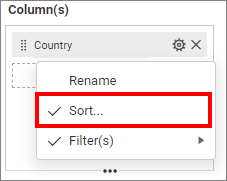
Filtering data
You can apply filters by selecting the filters option in the settings. For more details, please refer to the filter.

To view all the records, click on Show All Records.
Similarly, you can add the Measures and Expression Columns into column field.
Multi-Level Drill Down
If you add more than one value to the Columns field, the alert message will be shown to enable the drill-down option. Click Yes to enable the option.
NOTE: If you click
No, a single value will be added to theColumnsfield.
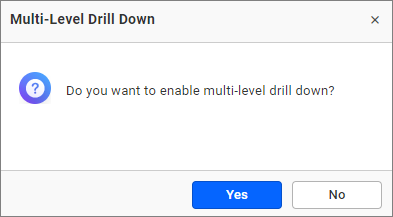
The zoomed in view of the chart region has been selected.
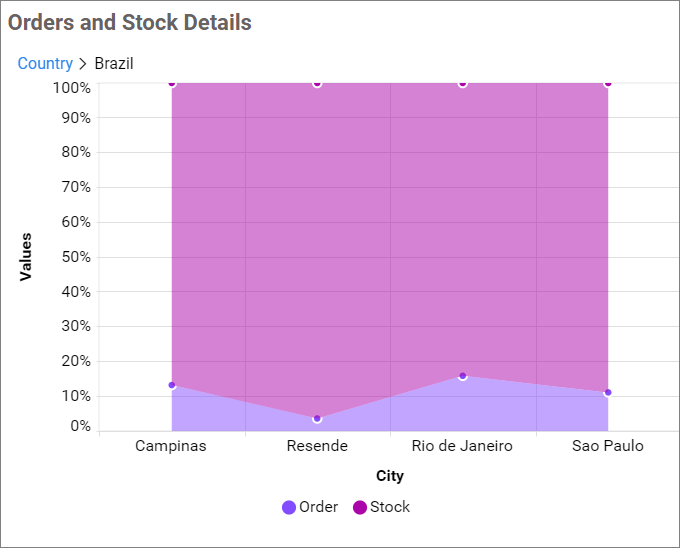
Adding Rows
You can drag and drop the Measure or Dimension into the Rows field.

You can apply a filter and sort option for the rows field, if required.
This will render the chart in a series.
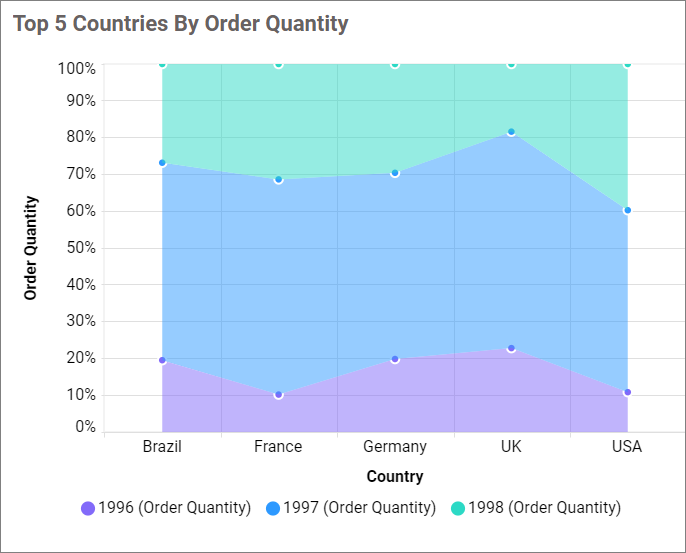
Hidden Column
Hidden columns are useful in cases where we do not want the fields to be included in the visualization, but only used for linking, filtering and view data.

We can configure both measure and dimension fields into the hidden column. For measures, we will have all the settings we have for the measure fields except for formatting and filtering.

In the case of dimension fields, we will have the following options only. In Date fields, we will have all available types except sorting, relative date filter, settings, and filters.


Linking
The primary use case for hidden columns is linking. When hidden columns are configured, we can see that the fields configured in hidden columns are listed in the linking section. By configuring the column in linking, we can pass the corresponding column value in the linking parameter.
Measure Based Example: If we want to pass the number of matches played as a URL parameter but do not want it to affect the visualization, we can configure the matches in the hidden columns and include them in the link.
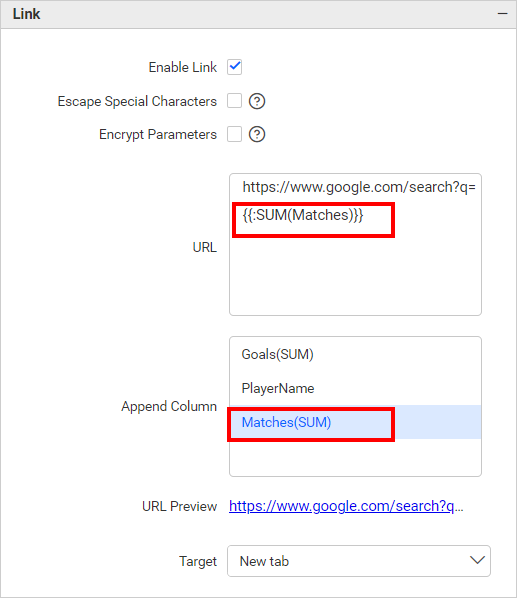
Dimension Based Example: If we want to pass the number of Team Name played as a URL parameter but do not want it to affect the visualization, we can configure the Team Name in the hidden columns and include them in the link.
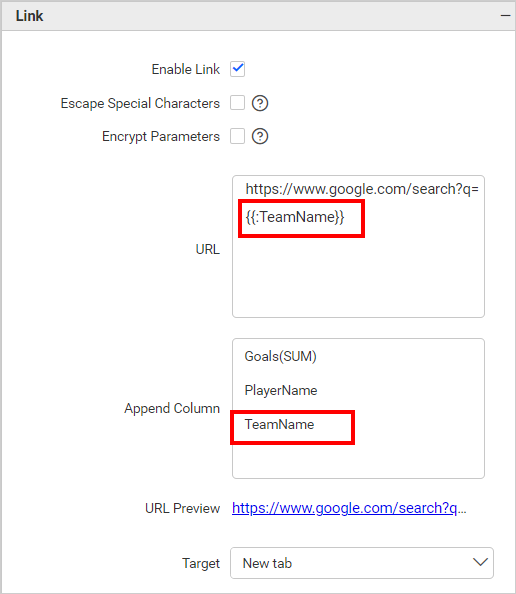
Filtering
You can use hidden columns to filter data in the visualizations. Configure the hidden columns and click the filter icon below.
![]()
Click the Custom button, which is highlighted in the filter configuration dialog image below. This will display a list of all the fields that have been configured in the widget. Retain the field that is configured in the hidden column and remove the other fields. Finally, click the Update button.

Now, we can see in the image below that the data is filtered based on the hidden column field instead of the actual column that we bound in the widget.
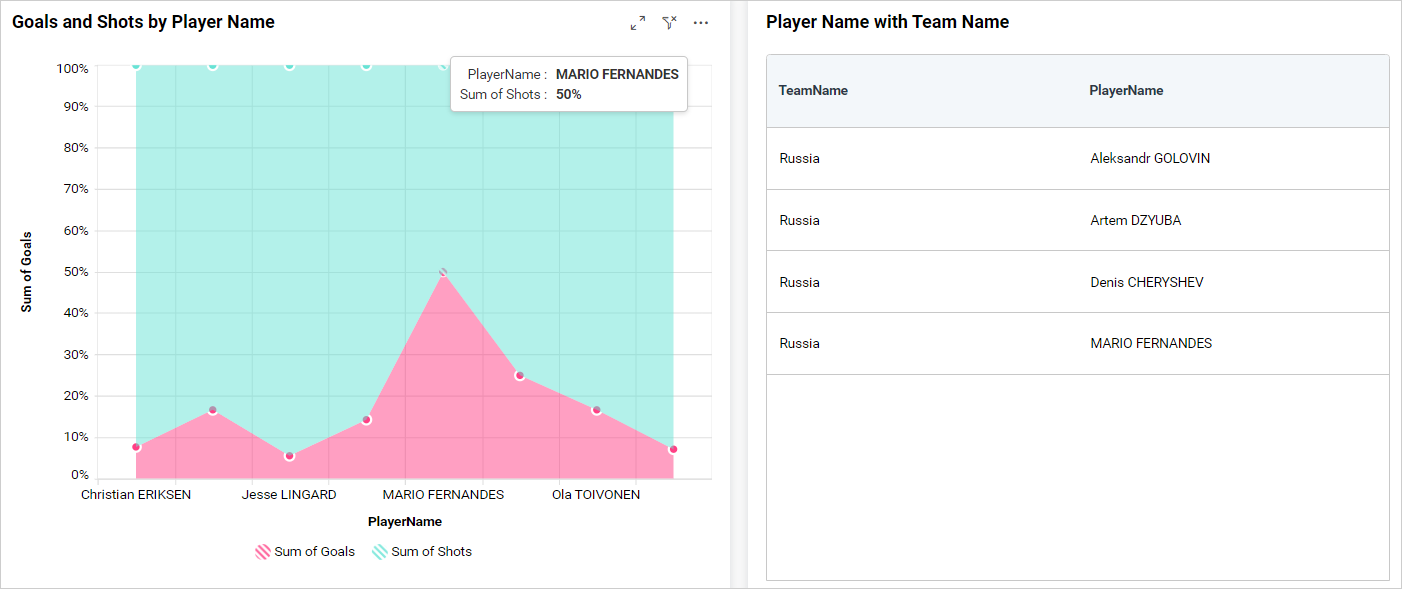
For more details about filtering the widget data, refer to the Cross Filter Configuration documentation.
View Data
You can view the data in the hidden columns in the underlying data view. This is useful for checking the data in more detail and can help you identify any issues with the data.

NOTE: We do not recommend configuring lower hierarchy data in hidden columns, as indicated by the information icon in the
Hidden Columnsection.
![]()
The chart below displays the goals and Attempts On Target for each team without any hidden columns.

If we configure the lower hierarchy data (Player Name) in hidden columns compared to column and row field data, the data configured in the widgets becomes duplicated, and each individual column is split based on the hidden column field. This affects the visualization of the chart, as can be seen in the image below.

How to format 100% stacked area chart?
You can format the 100% stacked area chart for better illustration of the view you need using the settings available in the Properties pane.
To configure data into 100% stacked area chart follow the steps
-
Please drag and drop the 100% stacked area chart onto the canvas and resize it to the size you need.
-
Configure the data into a 100% stacked area chart.
-
Please focus on the 100% stacked area chart and click on the widget settings.
![]()
The property window will be opened.
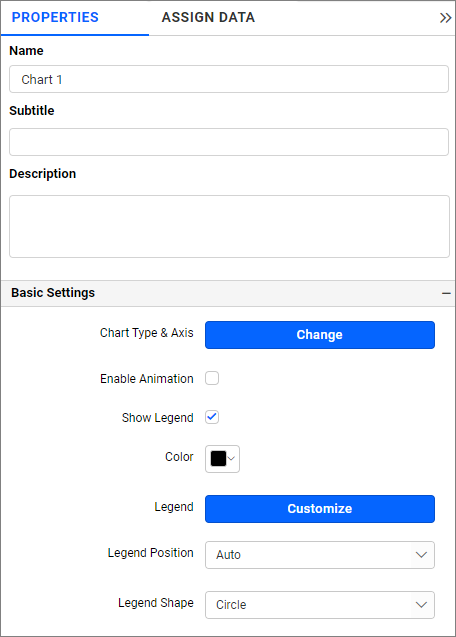
You can view the list of properties that are available for the widget with the default value.
General Settings

Name
This feature allows you to modify the title for the 100% stacked area chart widget.

Subtitle
This widget allows you to provide the subtitle for the spline area chart.
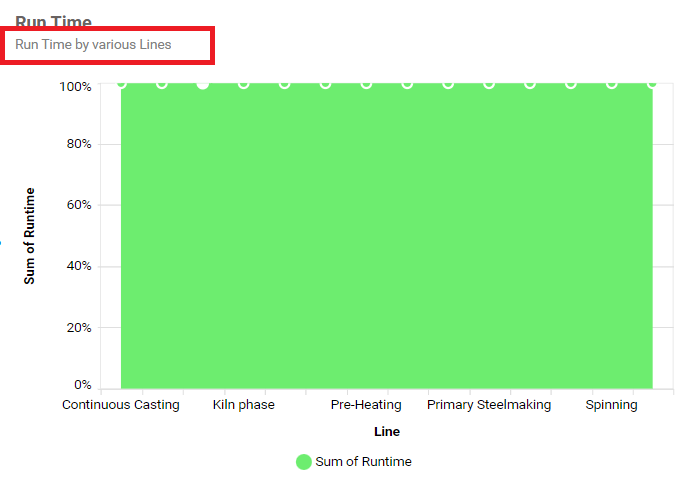
Description
This spline area chart widget allows you to provide the description.

Basic Settings
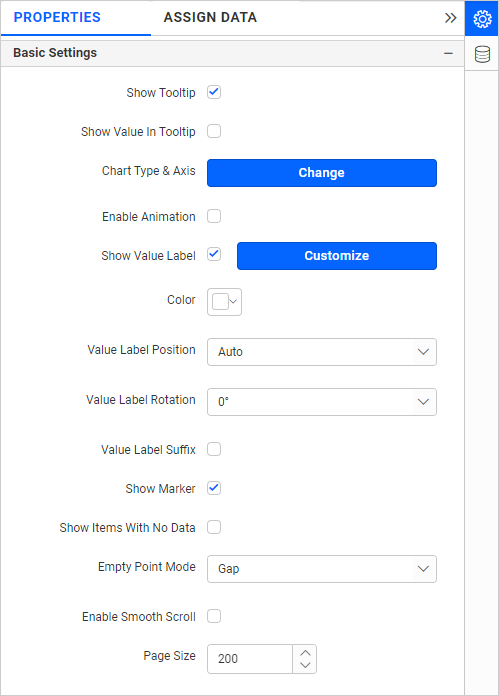
Show Tooltip
This option allows you to toggle the visibility of the tooltip in a chart.
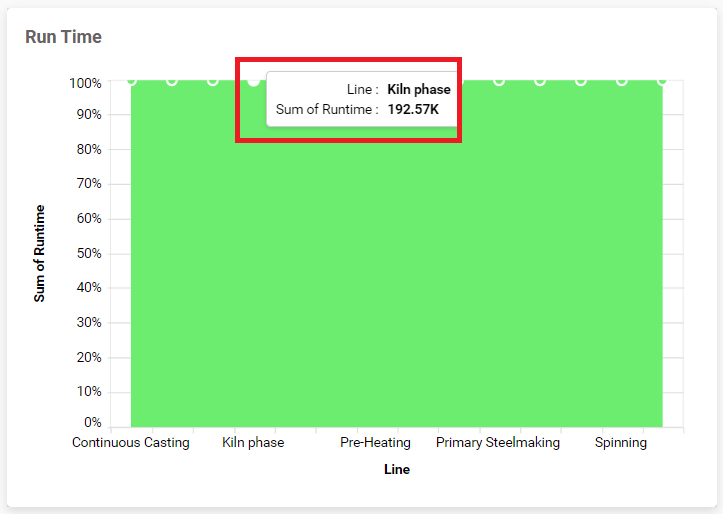
Show Value in Tooltip
As it is a percentage type, the values will be shown with percentages when you hover over the chart. If you enable this option, the value will be shown in the tooltip.
Chart Type and axis
To open the Chart Type and Axis Settings dialog, click the Change button.

Chart Type: This feature allows you to switch the widget view from the current chart type to a different chart type.
Secondary Axis: By default, the configured field is plotted as the primary axis. If you enable this option, the selected field will be plotted as the secondary axis.
Enable Animation
It animates the measure values when you toggle the Enable Animation.
Show Value Labels
This feature allows you to switch the visibility of value labels.

If you disable the Show Value Labels properties, the dependent properties, which are color, value label position, value label rotation and value label suffix, will be hidden.
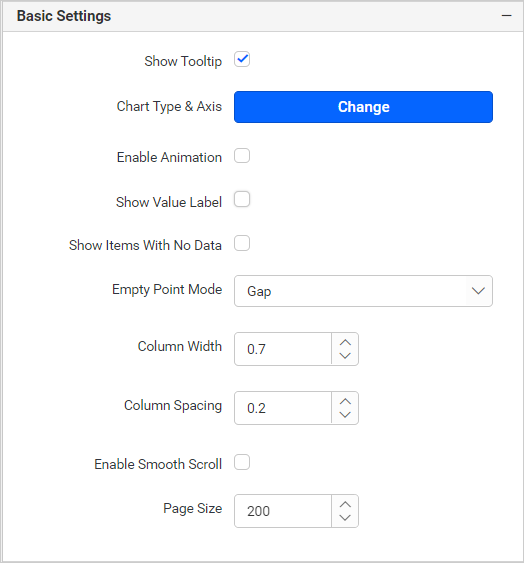
Customize
This feature allows you to customize the toggle visibility of value labels in each series.
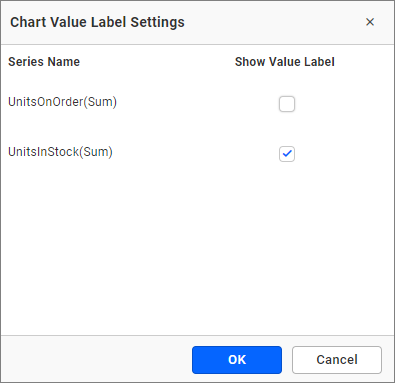
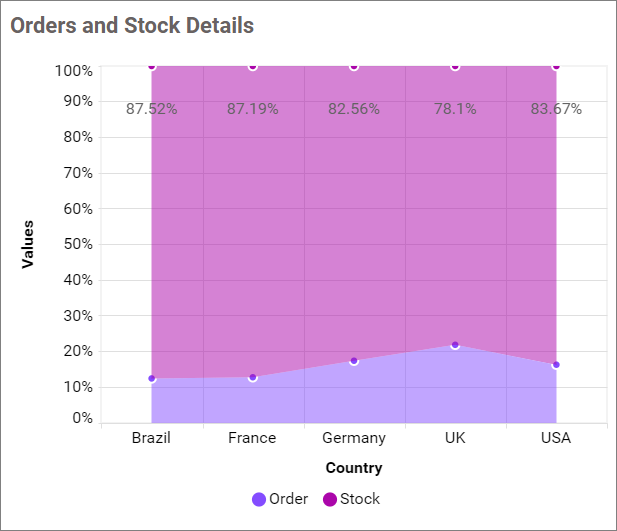
Value Label Color
This allows you to customize the color of the value label.


Value Label Position
This option allows you to customize the position of the value label in a chart. By default, it is set to Auto, so the label position for the percent stacked area chart will be set as middle.

Value Label Rotation
This allows you to define the rotation angle for displaying the value labels.
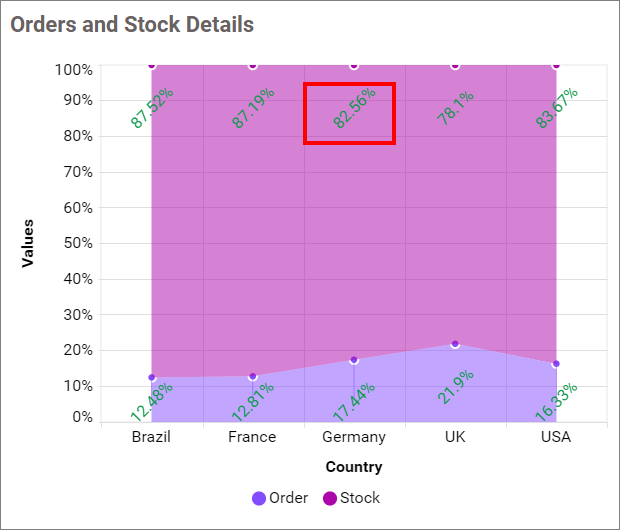
Value Label Suffix
This feature allows you to display or hide the suffix value of value labels.
Suffix Value
This allows you to customize the suffix value of value labels.
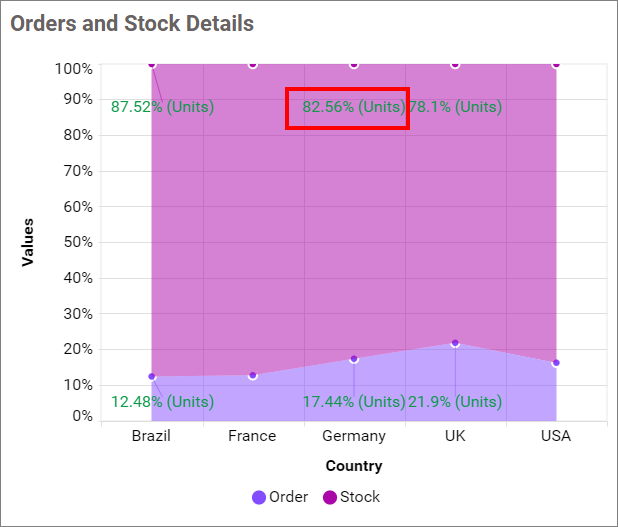
Note: When the height and number of data in the chart were increased, the value label was hidden. Use the label rotation property to make the label visible.
Show Marker
This allows you to toggle the visibility of markers, which label and adorn each data point in the chart series.
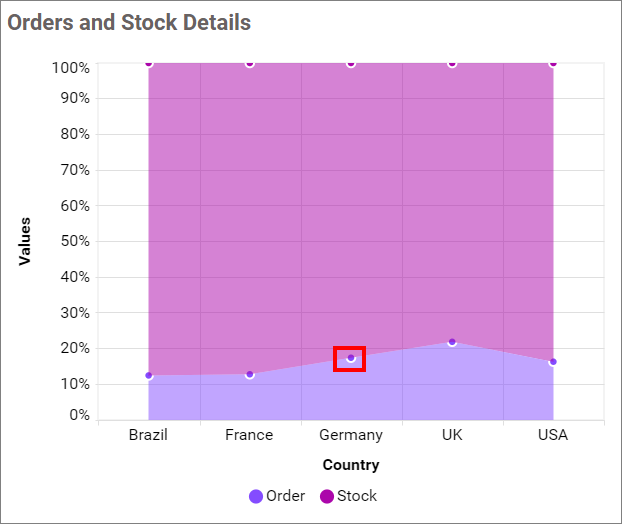
Show Items With No Data
This allows you to show the data for which column does not have any values.
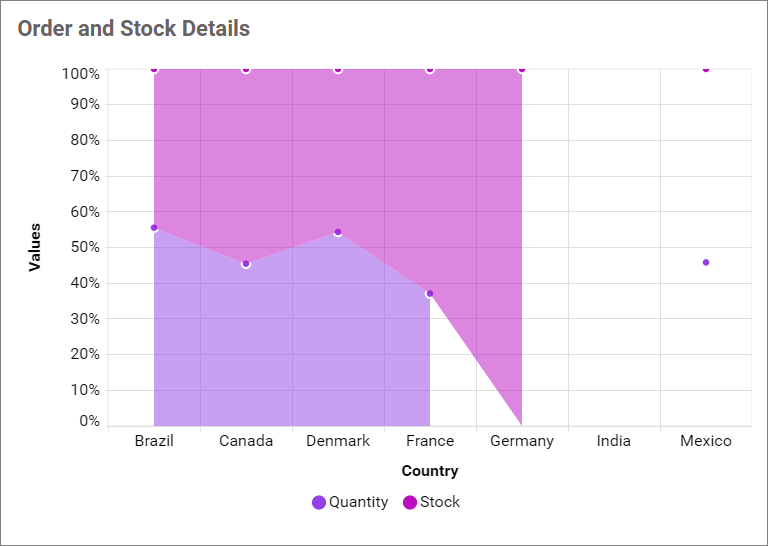
Empty Point Mode
This option allows you to handle the display mode of the data point values when they are null or undefined.

Gap
This option allows you to display the null or undefined values as gaps.

Zero
This option allows you to display the null or undefined values on the zero axis.
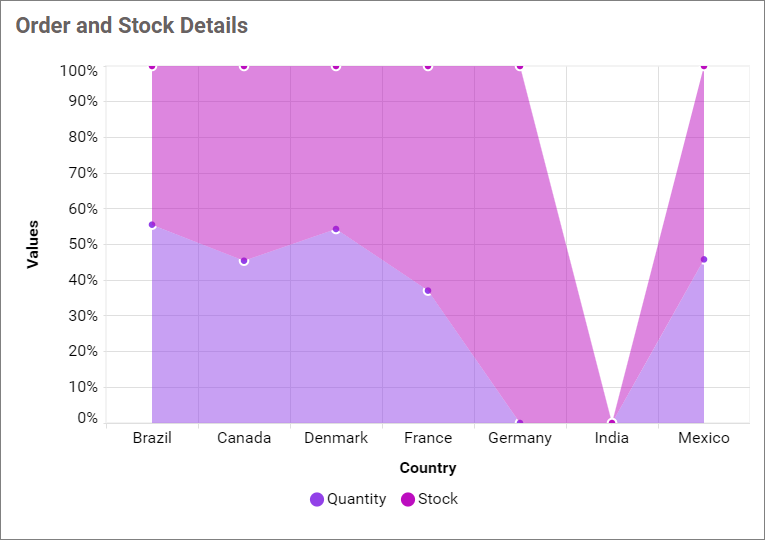
Average
This option enables you to present the null or undefined values using the average value.
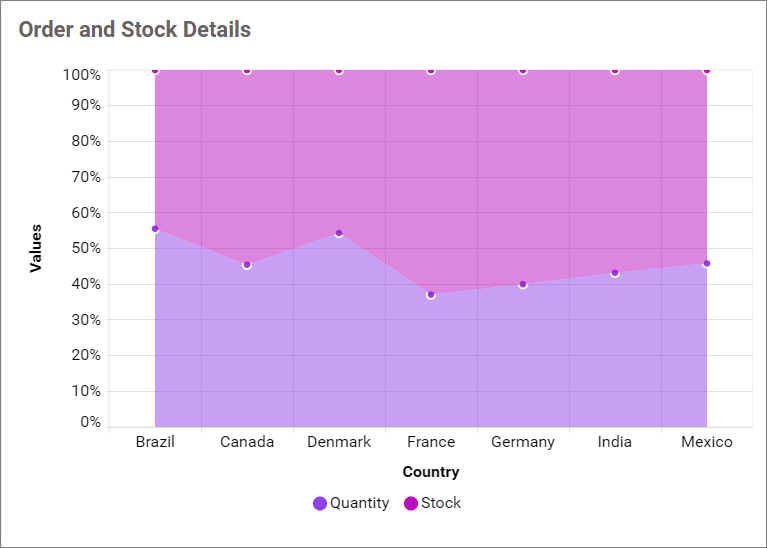
Enable Smooth Scroll
By enabling this support, the size of the chart scroll bar thumb will be calculated based on the total number of records. This will allow you to view the last record by simply scrolling once.
Page Size
This option allows you to specify the number of records that need to be fetched on the initial load.
Legend Settings
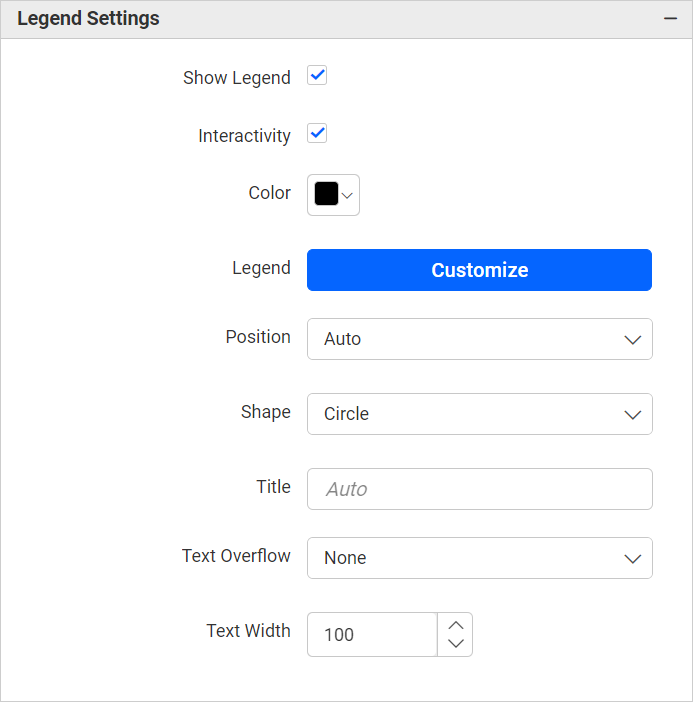
Show Legend
A legend is a text used to describe the plotted data. This allows you to toggle the visibility of the legend in the chart and also change the position of the legend text by selecting through the combo box.
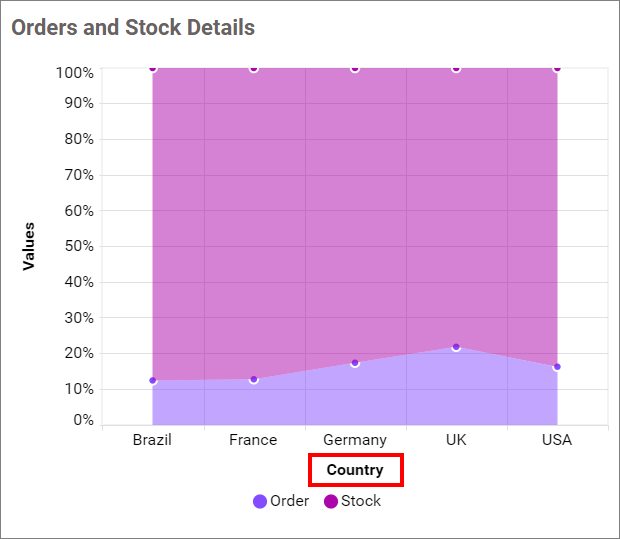
Enabling the option of Custom Legend Text will allow you to define a custom text, using the text area, to display for each legend series in the chart (selected through the combo box).
Legend Interactivity
The chart’s legend interactivity option allows you to control the behavior of the chart legends. This option provides the ability to make chart legends non-clickable, which can be particularly useful in situations where you do not want users to hide or show series data by clicking on the legend. This feature might also be beneficial when displaying crucial data that should always be present for accuracy and context.
Disabling the Interactivity feature in the Legend Settings category prevents you from clicking on the legends.
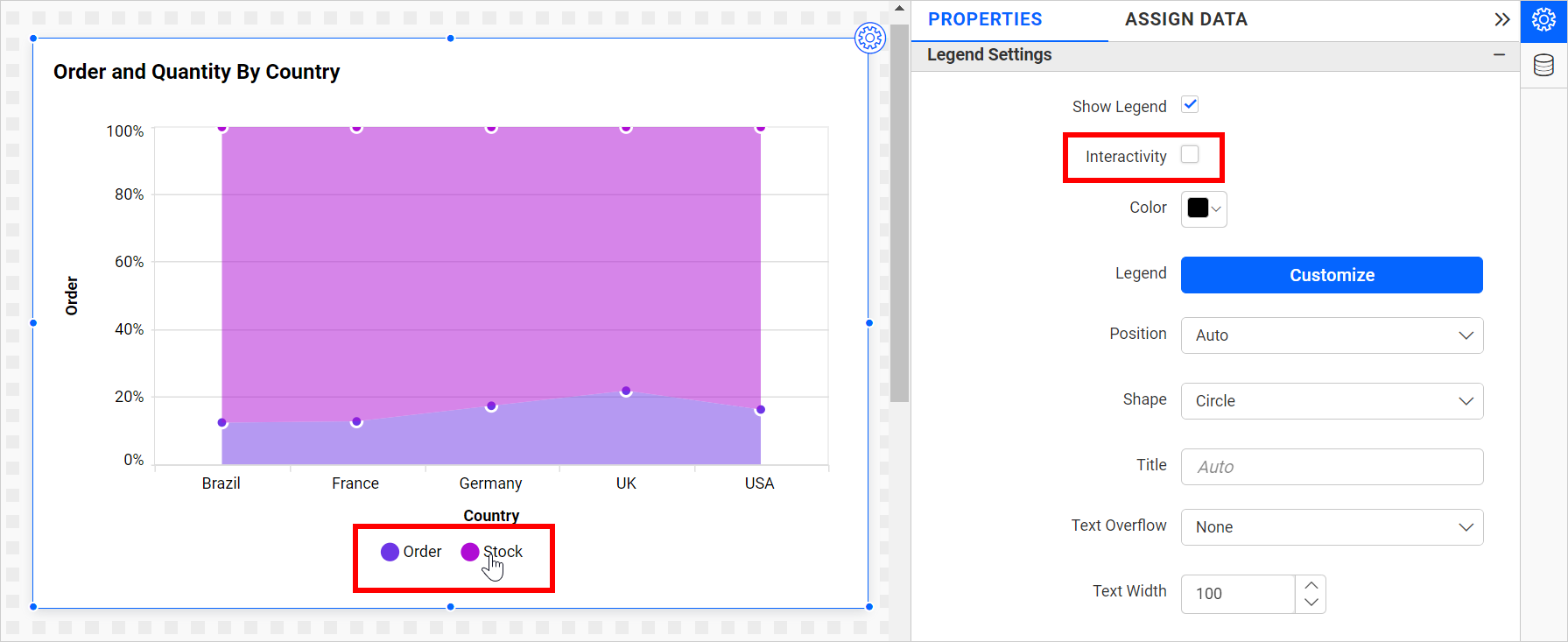 Enabling the Interactivity feature in the Legend Settings category allows you to click on the legends.
Enabling the Interactivity feature in the Legend Settings category allows you to click on the legends.
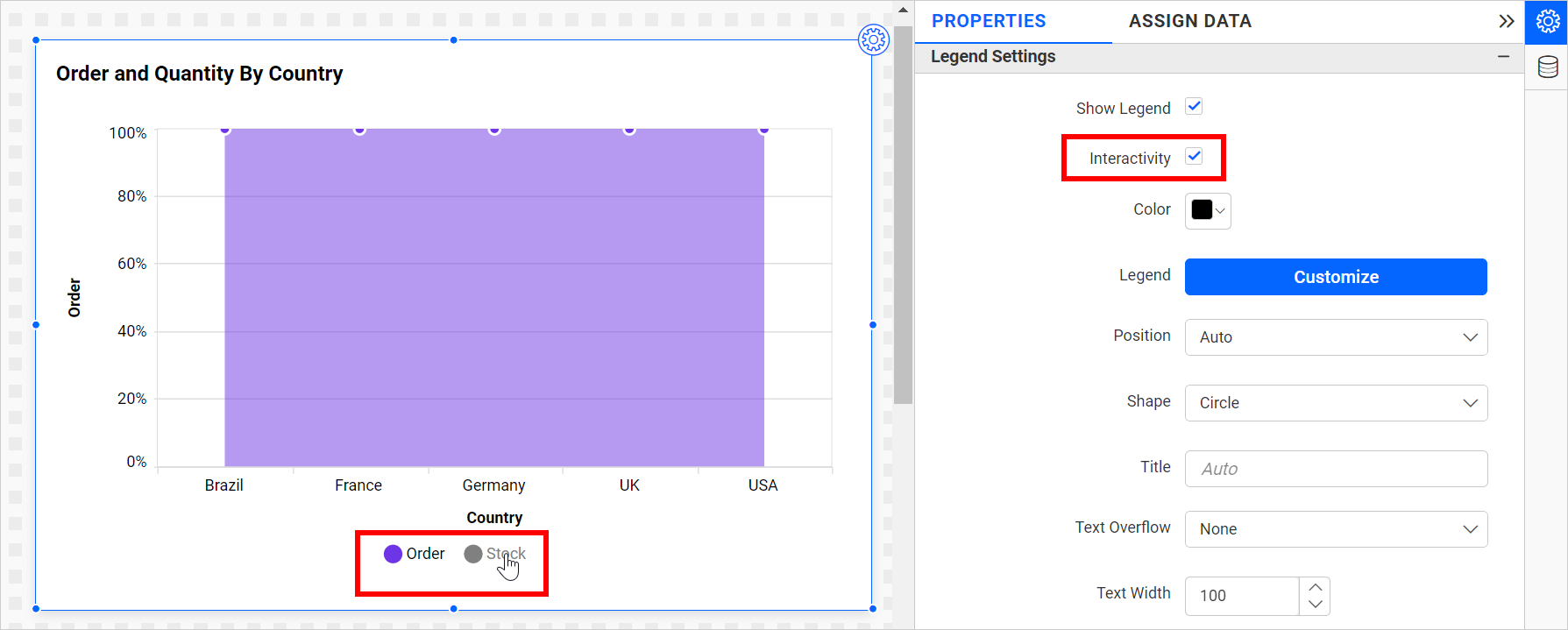
Legend Label Color
This feature enables you to modify the title and label colors of the chart legend.
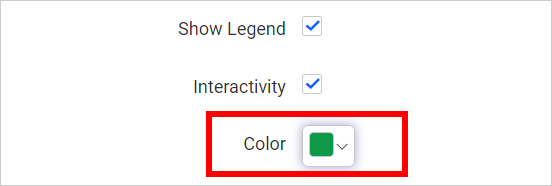
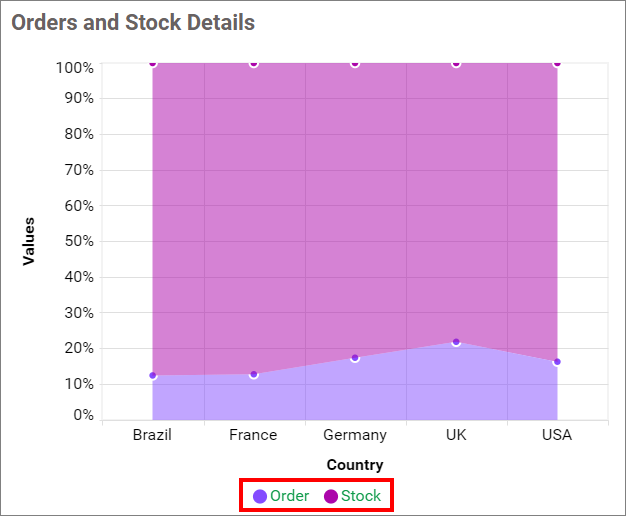
Customize
You can customize the legend text by using the Custom Legend Settings dialog. This dialog displays a list of legend text labels on the left, with a corresponding text area on the right. In this text area, you can add formatted text that will be displayed instead of the default legend text.
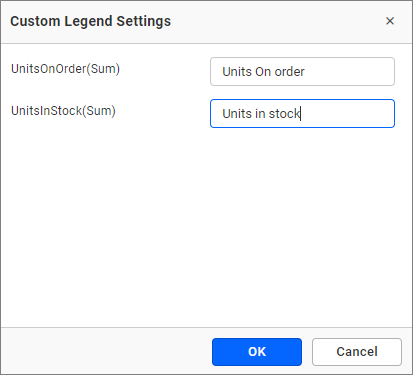
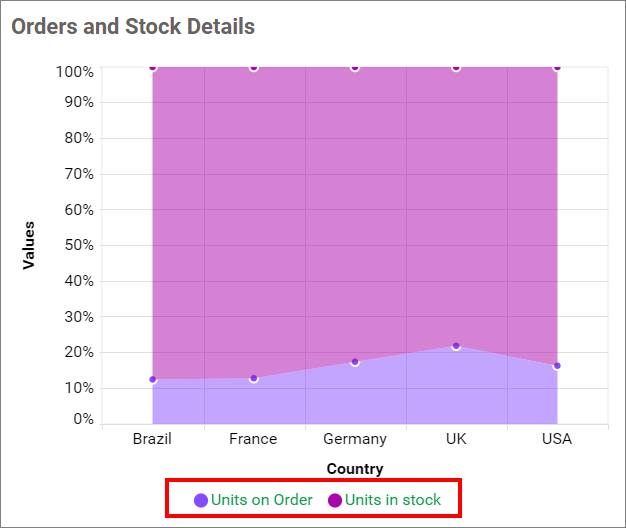
Custom Legend Settings when giving Row Section
You can customize the legend text using the Custom Legend Settings dialog. This dialog will display the legend text list as labels on the left and a corresponding text area on the right to add formatted text to be displayed instead. When a column is added to the Row section, this dialog will also show two options, Individual and Group, at the top to toggle between.
Individual
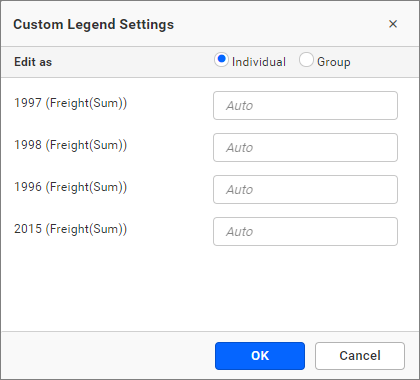
Group
{{ : Row }} ({{ : Y Value }})
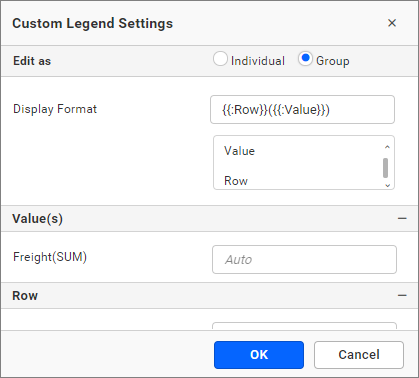
Legend Position
A Legend is a text used to describe the data plotted. This option allows you to place the legend at the position of Left, Right, Top, and Bottom.
Legend Item as Dropdown
Legends can be displayed as a dropdown menu when the legend position is set to “dropdown.” When you hover over a chart, a legend icon appears. Clicking on this icon will bring up a legend dropdown. This feature allows you to toggle the visibility of the legend in the chart.
This option will hide the legends in the chart area, resulting in increased chart space and enhanced visibility.
The chart legend dropdown option can be used to simplify viewing complex charts with multiple data sources. For example, if you have a chart displaying sales data for the different years, you can use the legend dropdown to deselect all other years and focus only on a specific year.
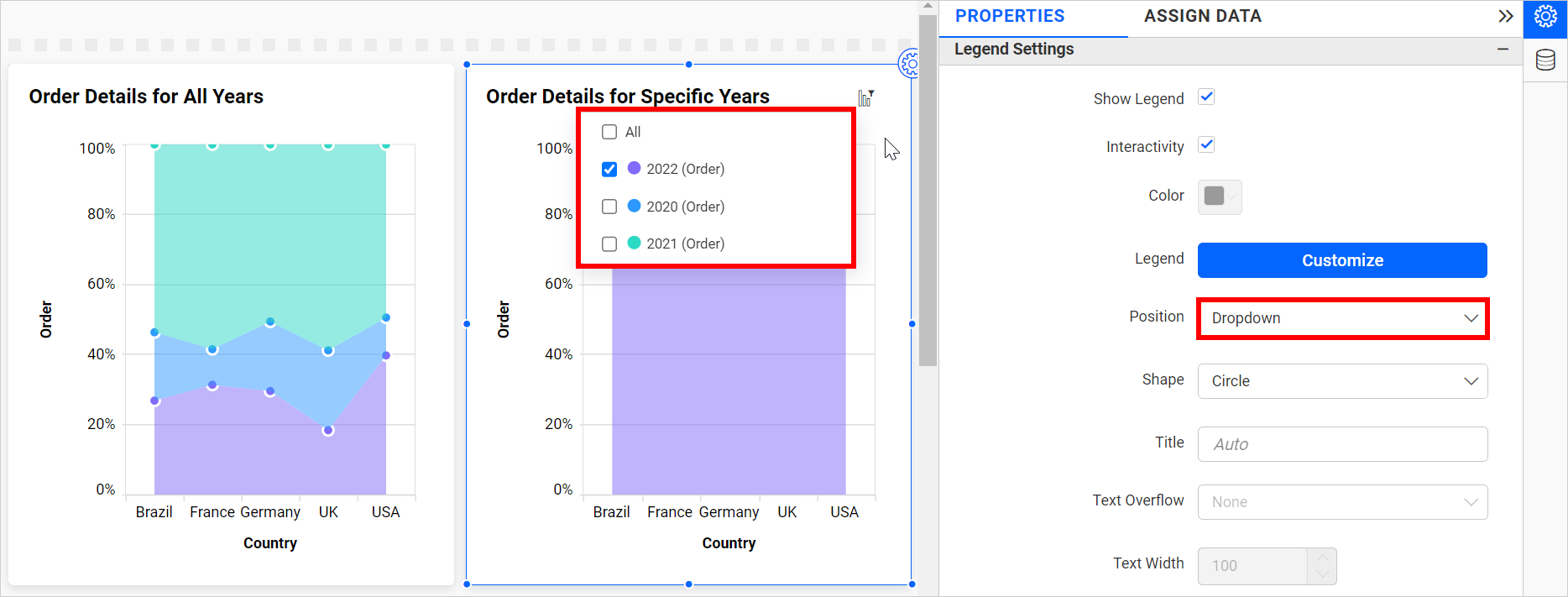
Legend Alignment
Legend Alignment enables you to control how the legend is positioned within its allocated space. For detailed guidance, refer to the Legend Alignment section.
Legend Shape
This allows you to change the shape of the legend.
Circle
This option enables you to modify the shape of the legend to a Circle.
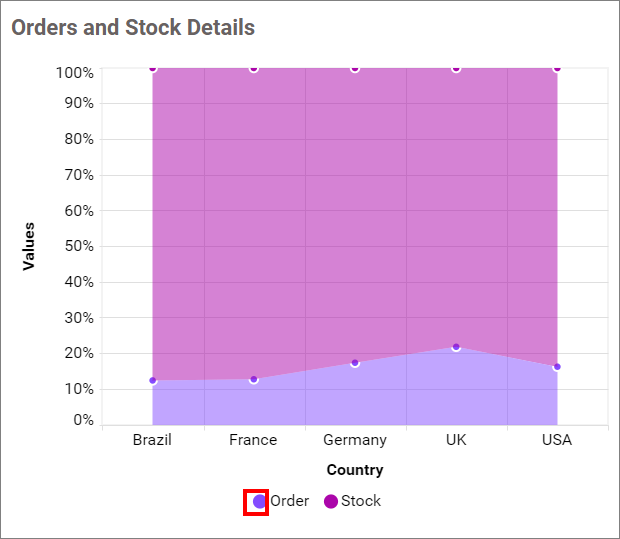
Series Type
This option allows you to change the shape of the legend in a Series.
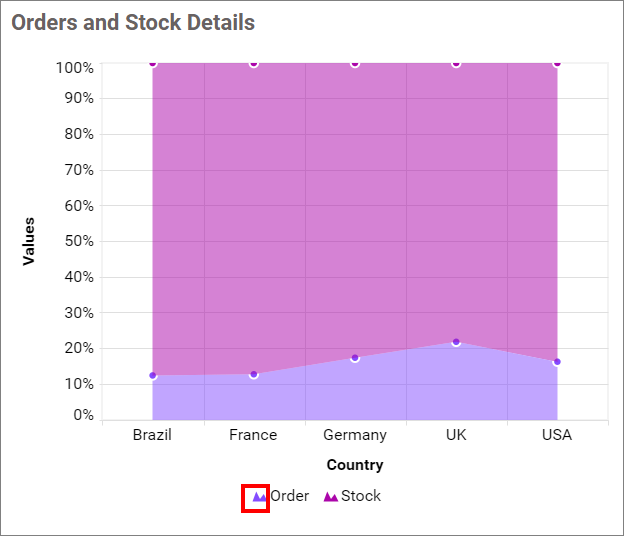
Legend Title
This allows you to add the legend title for the chart. It will reflect with the Show Legend.
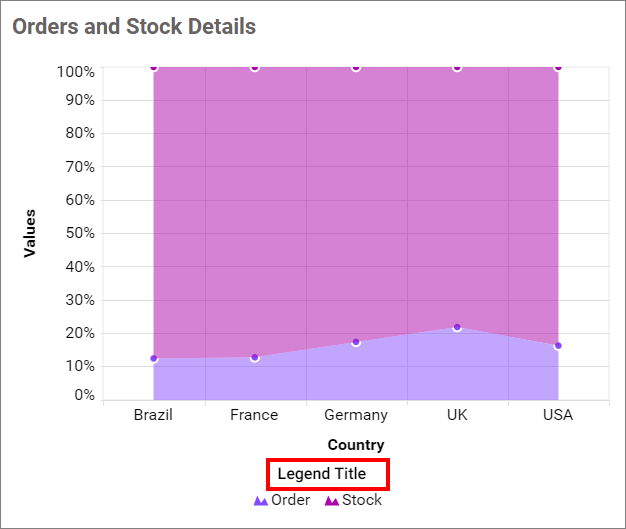
Text Overflow
This option enables you to customize the legend text based on the value of the Text Width property.
None
This option enables you to display the legend items without any wrapping or trimming.
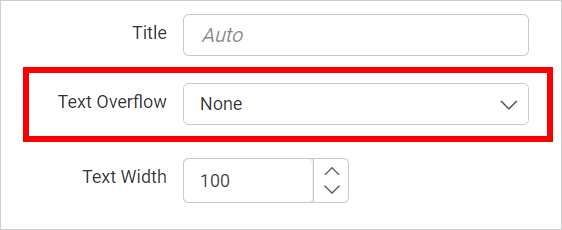
 Trim
Trim
This option allows you to trim the legend items if their legend exceeds the value of Text Width.

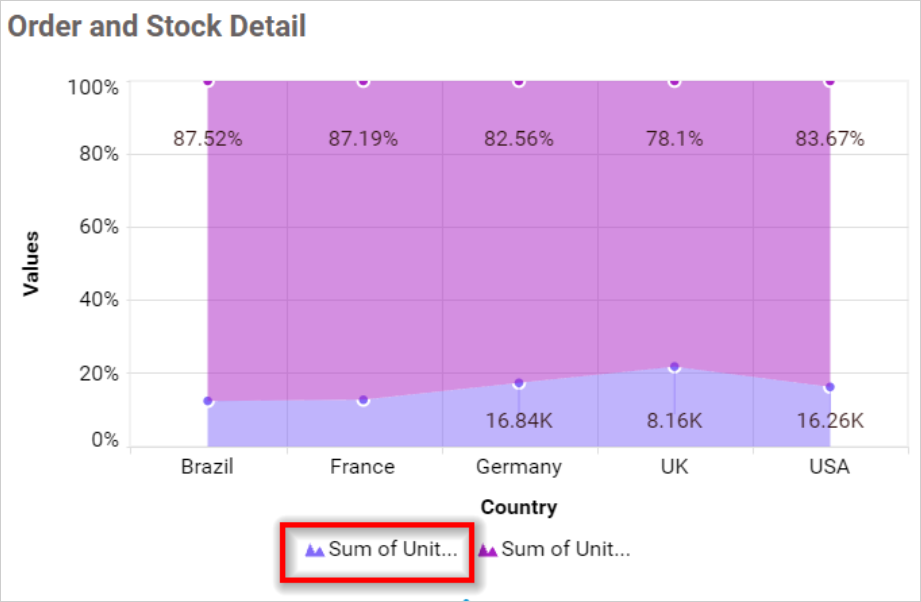
Wrap
This option allows you to wrap the legend items based on the value of Text Width.


Text Width
This option allows you to set the maximum width for the legend items, and it is applicable only if text-overflow is set as Trim or Wrap.

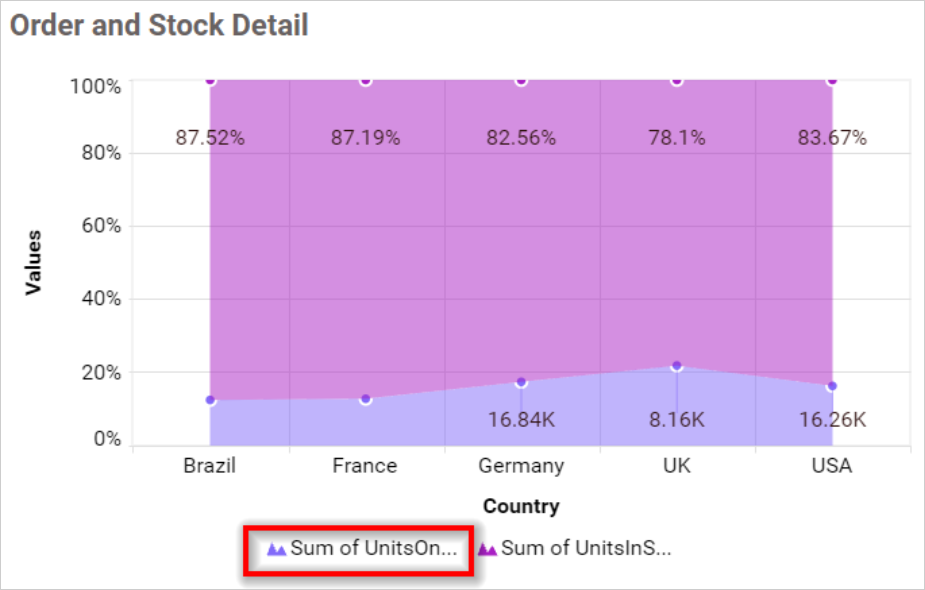
If you uncheck the Show Legend property in the property panel, the dependent properties, which are the legend color, legend position, customization button and legend title, are also hidden.
NOTE: For a single series, the legend won’t be visible.
Link
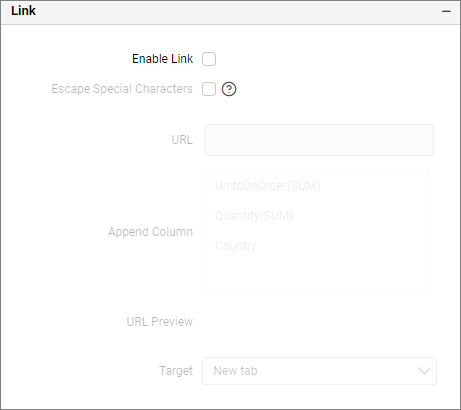
You can enable linking and configure it to navigate to a general URL, whether with or without parameters. For more details, please refer to the Linking.
Axis Settings
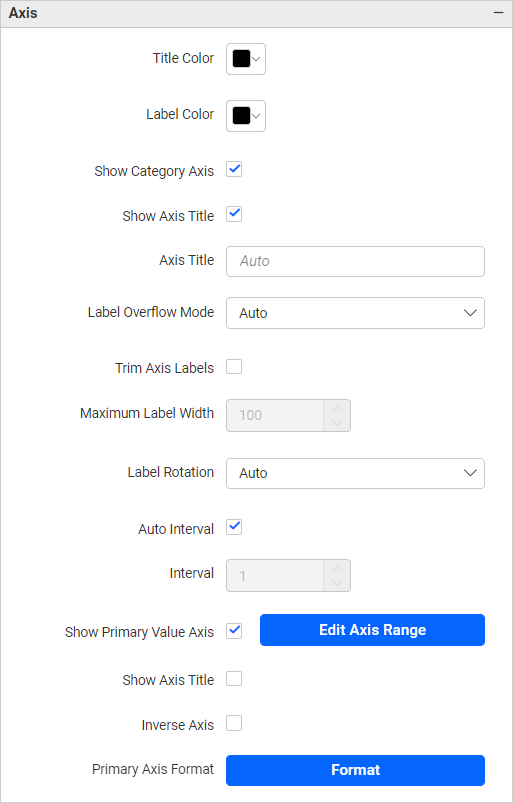
This section allows you to customize the axis settings in the chart.
Title color
This feature allows you to customize the color of the axis title.
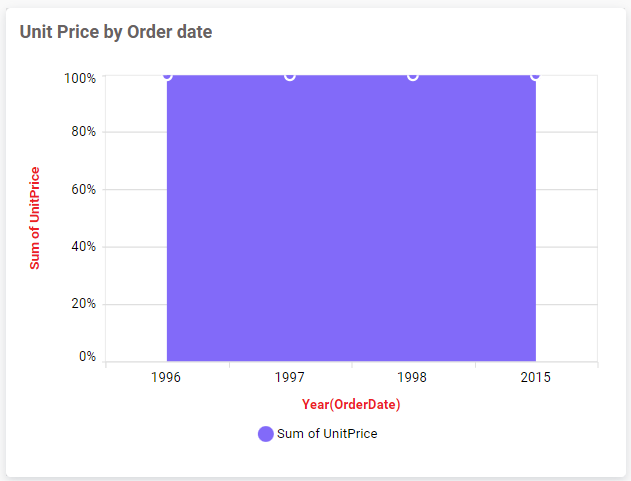
Label color
This feature allows you to customize the color of the axis labels.

Show Axis Border
This option allows you to enable or disable the axis border of the chart.

Show Category Axis
This allows you to enable the visibility of the Category Axis.
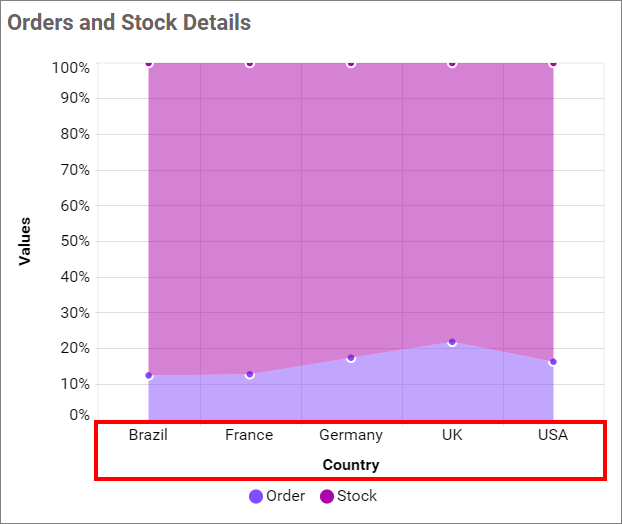
If you disable the Show Category Axis option, dependent properties such as the Show axis title, Axis title text, Trim overflow mode, Trim axis labels, Label Rotation and Auto Interval, option will be hidden.
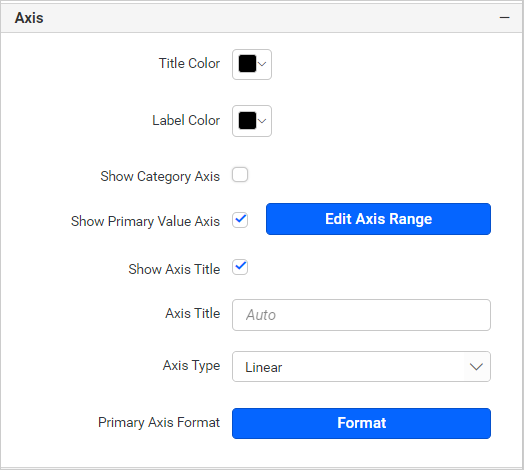
Show Category Axis Title
This allows you to enable the visibility of the Category Axis title.

Category Axis Title
This feature allows you to edit the title of the Category Axis for the chart, which will be displayed as the x-axis name of the chart.
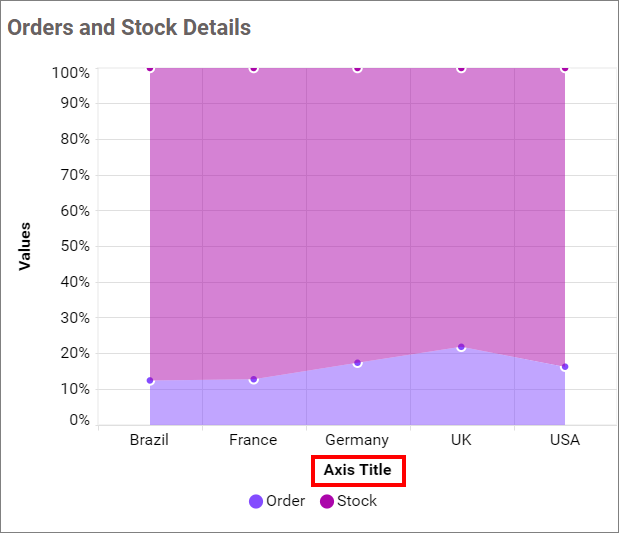
If we uncheck the Show Axis Title property, the Axis title text box property will be hidden.

Label overflow mode
This allows you to handle the display mode of the overlapping labels in the Category Axis.
Trim
This option trims the end of the overlapping label on the axis.

Hide
This option hides the overlapping label on the axis.
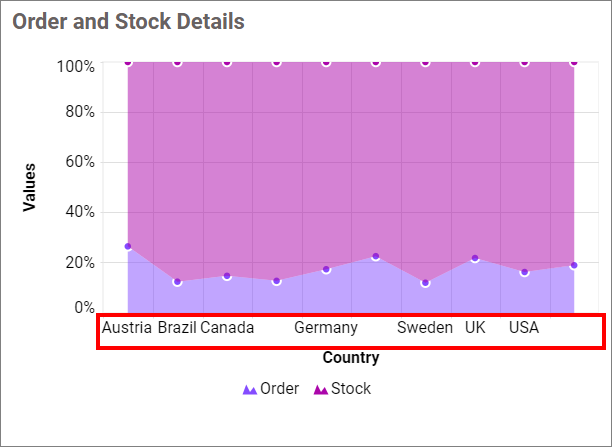
Trim Axis Labels
This option enables you to shorten the axis labels according to the value of the Maximum Label Width property.
Label Maximum Width
This option allows you to set a maximum width for the axis labels. It can also be customized when the trim axis label option is enabled.

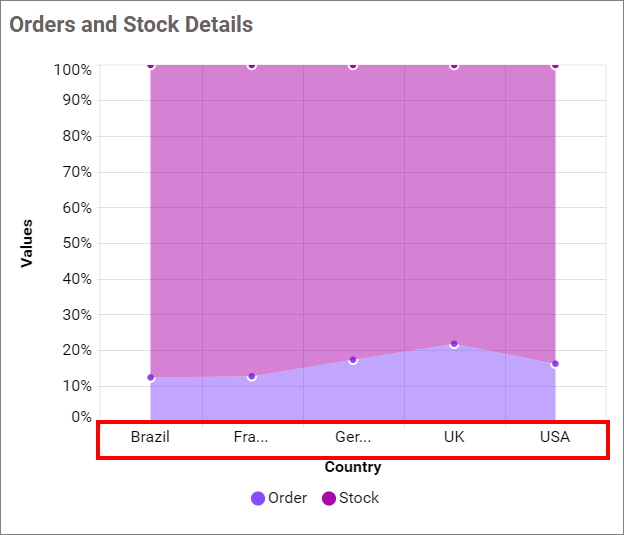
Category Axis Label Rotation
This feature allows you to specify the rotation angle for displaying the category axis labels.
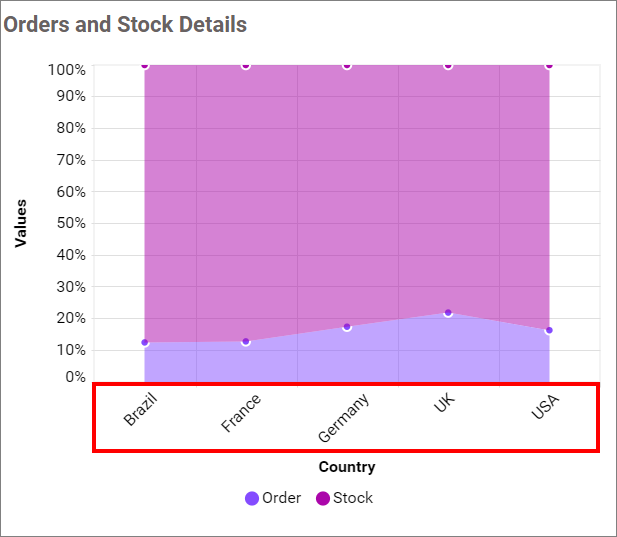
Auto Interval and Interval

By default, the Auto Interval property is enabled. The Auto Interval property is used to set automatic intervals based on the number of data points for category axis labels. If a user wants to customize the interval, then the user needs to disable the auto interval and set the required interval.

Show Primary Value Axis
This allows you to enable the Primary Value Axis for the chart.
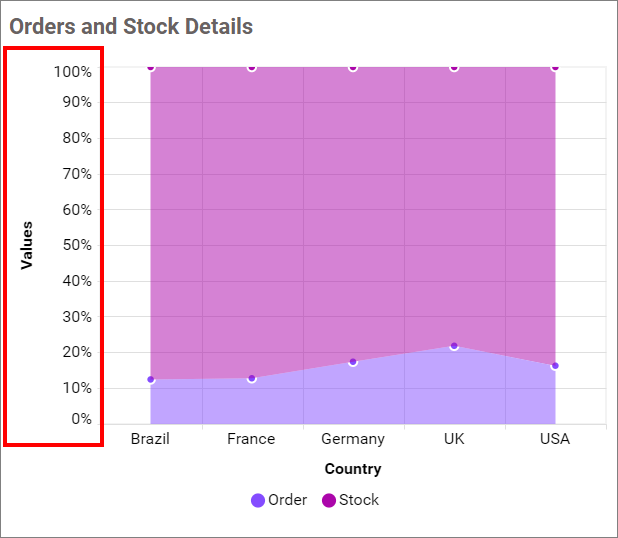
If you disable Show Primary Axis option, dependencies properties Axis title, Axis title text and Axis type, Axis Format properties will be hidden.

Show Primary Value Axis Title
This allows you to enable the visibility of the Primary Value Axis title of the chart.

Primary Value Axis Title
This allows you to edit the title of the Primary Value Axis, which will be reflected as the name of the y-axis on a chart.
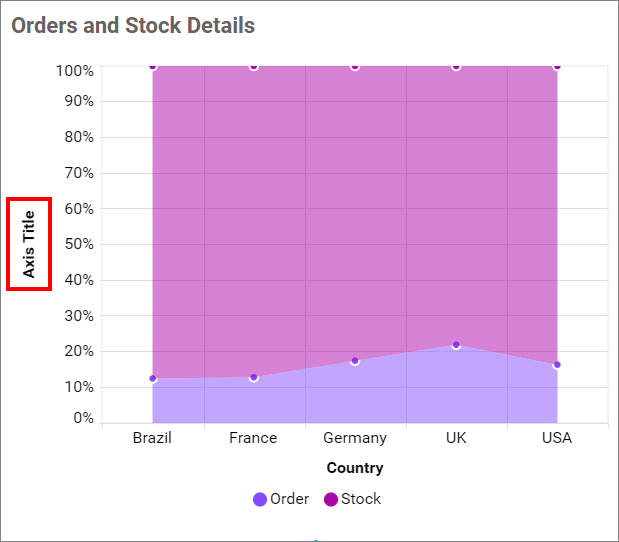
Inverse Axis
By default, the chart axis shows positive values at the top and negative values at the bottom. However, there are times when we need to invert the axis and display the negative values at the top and positive values at the bottom. For example, when we bind temperature data to the chart and want to display the negative values at the top, we can utilize this property.
When this property is enabled, the chart will display negative values on the top and positive values on the bottom.
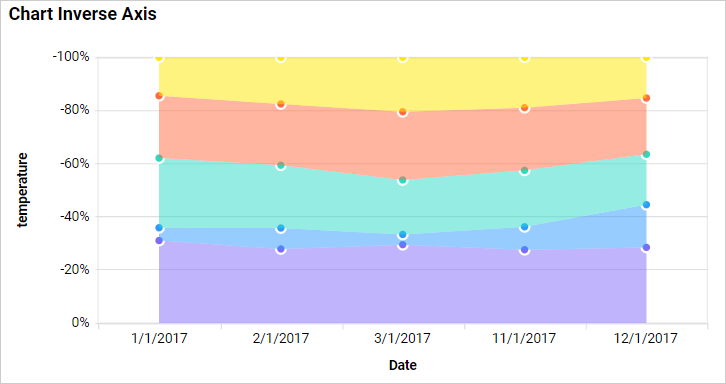
Axis Range Settings
This allows you to manually set the minimum, maximum, and interval values of the primary value axis through the Axis Range Settings dialog.
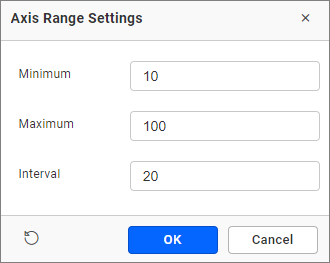
It will be reflected in the primary value axis of the chart.
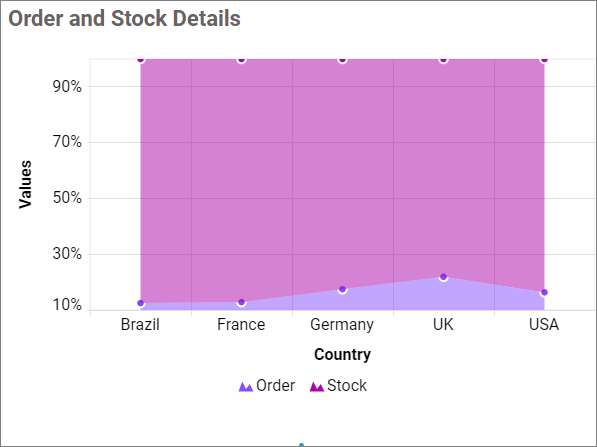
Parameter Support in Axis range:
This allows you to dynamically set the minimum, maximum, and interval values of the primary value axis through the Axis Range Settings dialog by using the dashboard parameter values. Only number-type dashboard parameter values are allowed in the axis range properties. You can create multiple types of dashboard parameters.
- Single parameter value.
- Range parameter value.
- Data source field based parameter values.
For more details about dashboard parameter, refer to the Dashboard parameter documentation.
Single Parameter Value:
A single value is stored in this type of parameter.
- Please create a dashboard parameter in the number type as shown below.
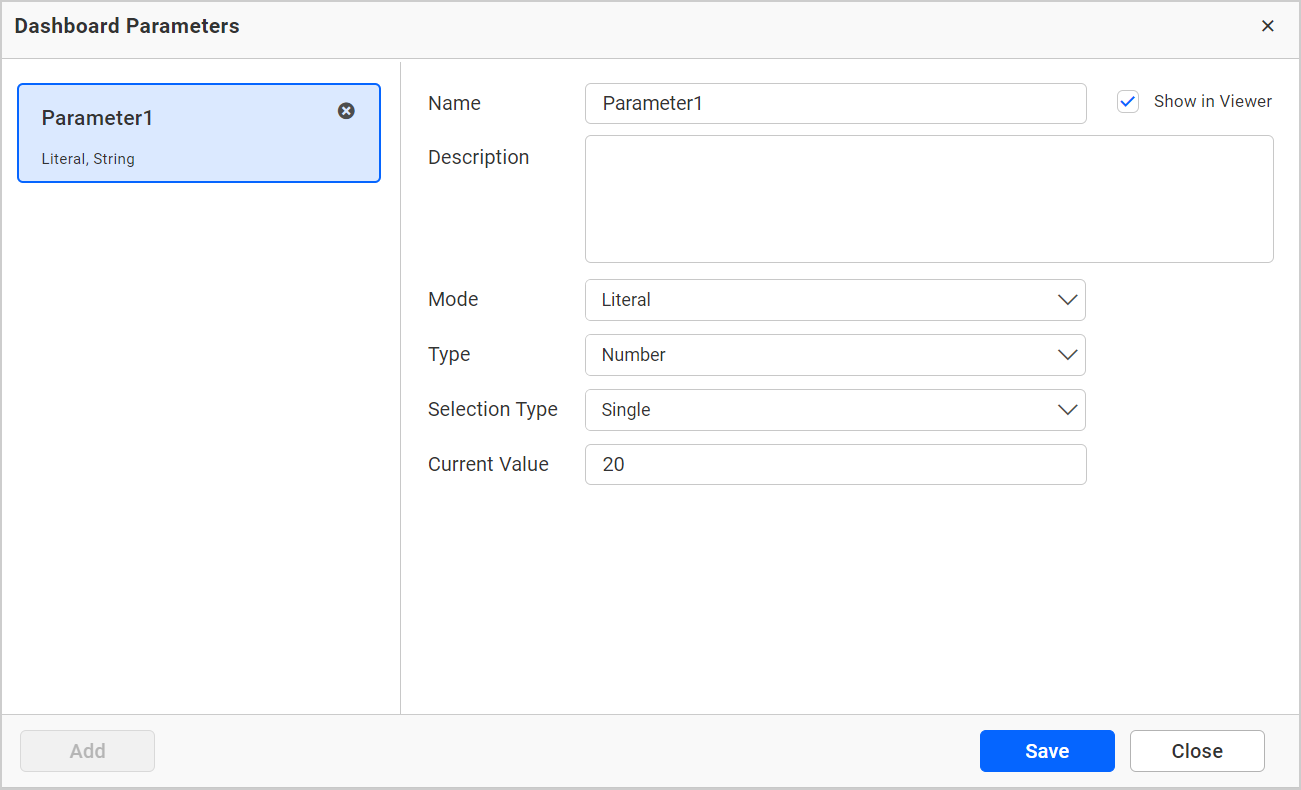
Click the axis range settings dialog and enter @ in any textbox (minimum, maximum, and interval). Select the parameter value (Number type parameter values are the only ones allowed).
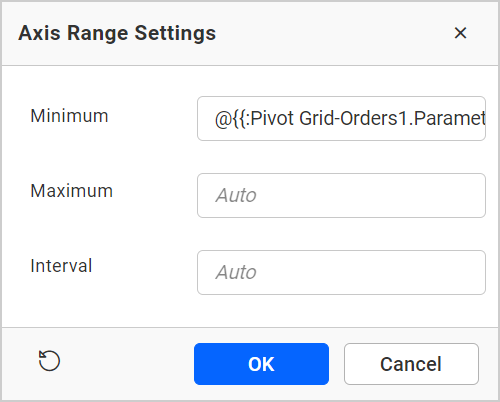
Now, the parameter value is reflected on the chart axis.

Range Parameter Value:
If you want to establish identical ranges in multiple instances, create a parameter value for the range type. This parameter type includes the starting and ending values.
- Create a parameter in range type.
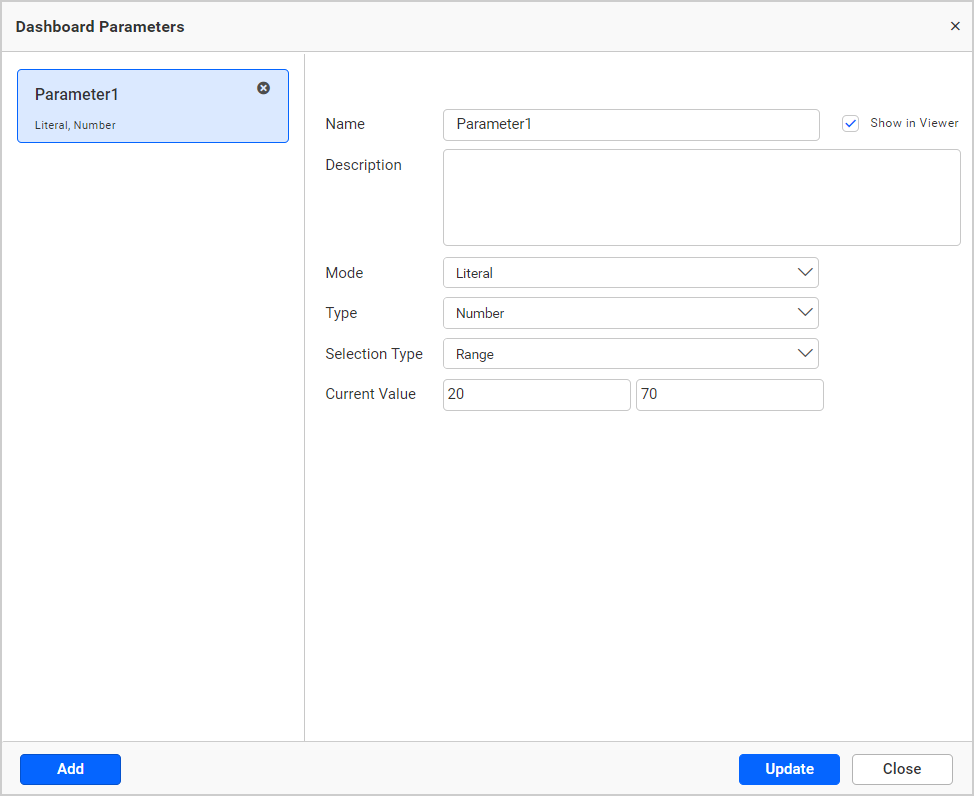
- Click the axis range settings dialog and enter
@in any textbox (minimum, maximum, and interval). The range parameter is split into start and end parameters. The value in the first textbox is stored in the start parameter, and the value in the second textbox is stored in the end parameter. Select the parameter value (only Number type parameter values allowed).
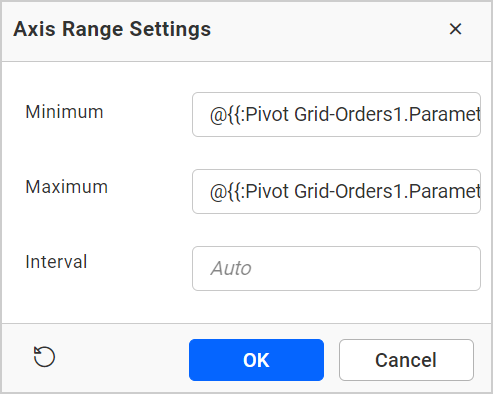
- The value of the parameter is reflected on the chart axis.

Data Source Field Based Parameter Value:
- Create a parameter in the data source type, choosing any field. The value should be based on the selected field value.
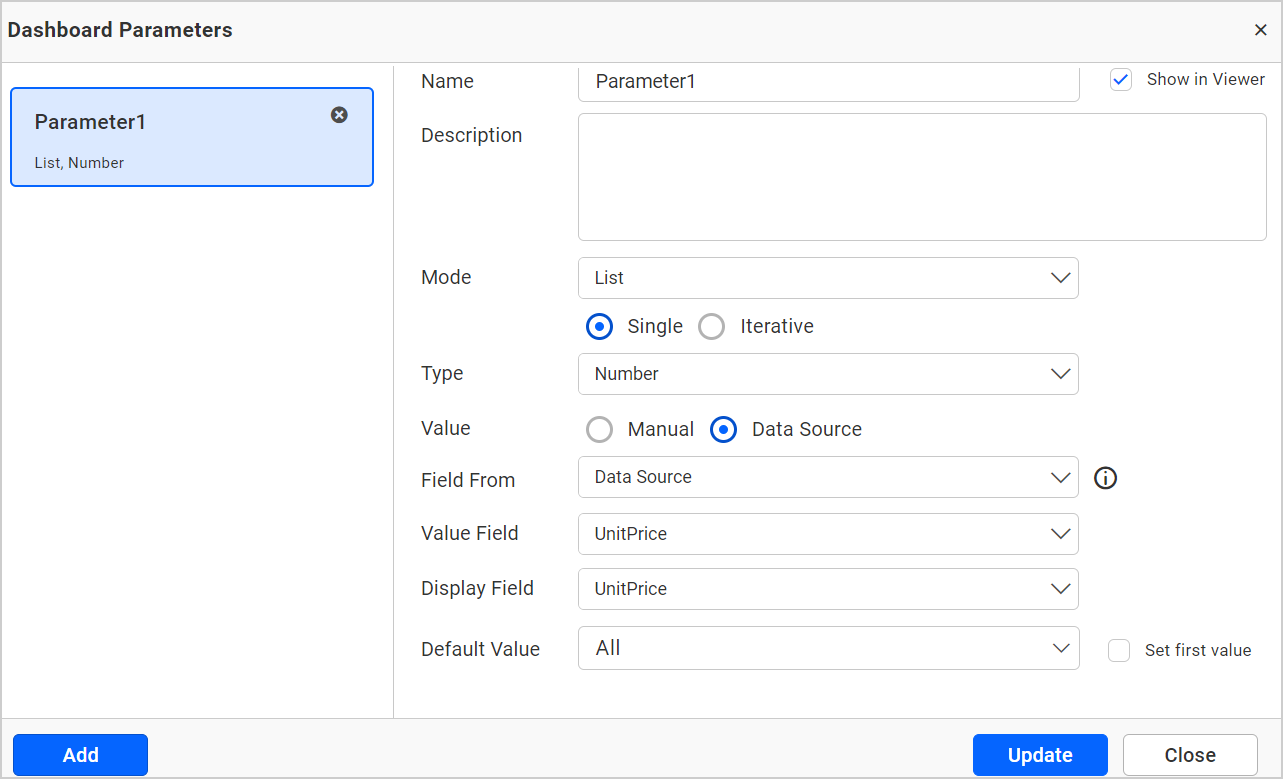
- Click on the axis range settings dialog and enter
@in any textbox (minimum, maximum, and interval). Then, select the parameter value.
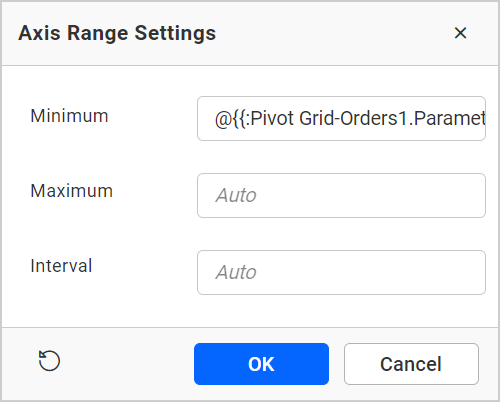
- The value of the parameter is reflected on the chart axis.
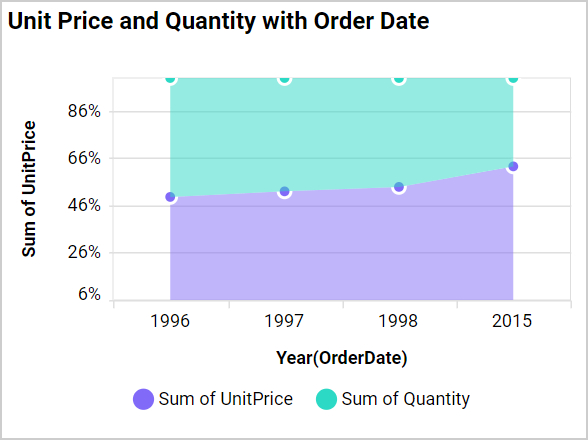
Grid Line
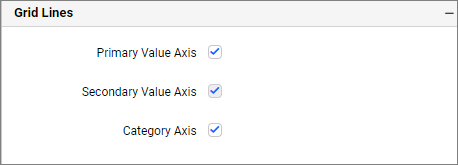
Primary value Axis
This feature allows you to enable gridlines for the Primary Value Axis in the 100% stacked area chart.
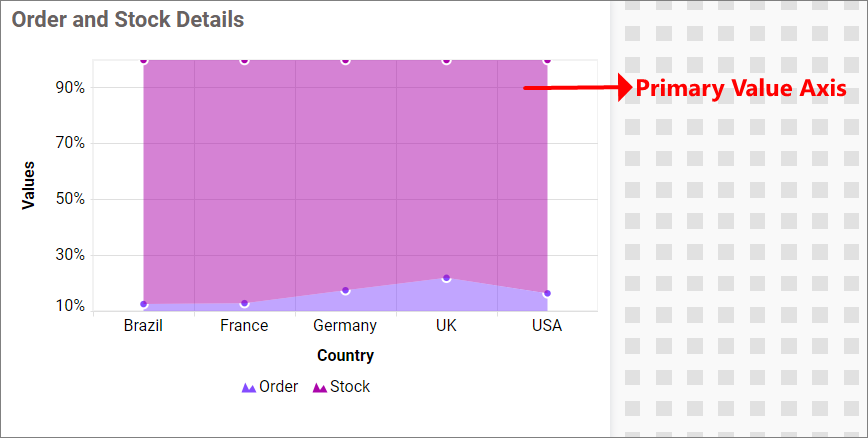
Category Axis
This allows you to enable the gridlines for the Category axis in the 100% stacked area chart.
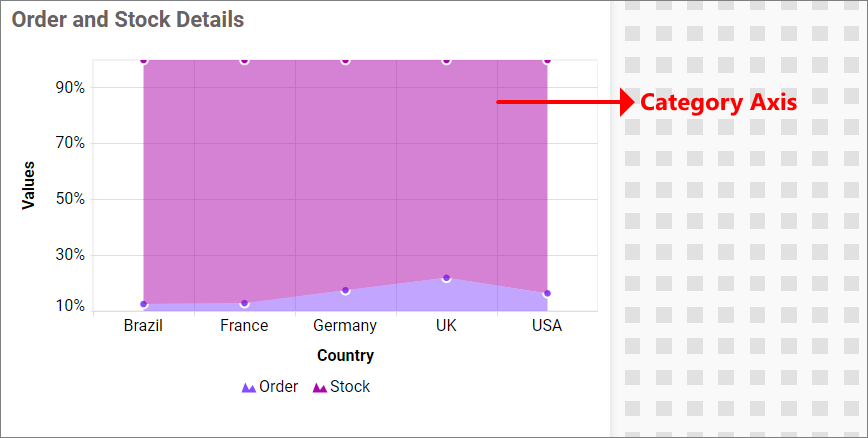
Series Palette
This allows you to apply color to chart series either by using a default palette or a custom color palette. The colors will be applied using the default palette by default. This series of settings will only be visible if you have configured the row section in the chart.
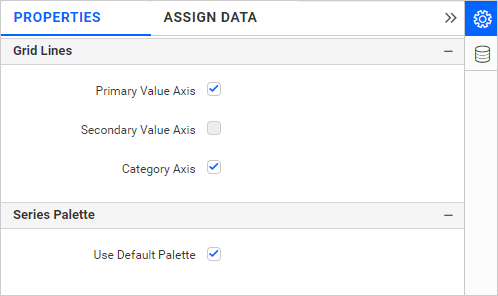
Use Default Palette
This option allows you to apply the default color for chart series.
By toggle off the Use Default Palette option, the Color Mapping Type will be shown.
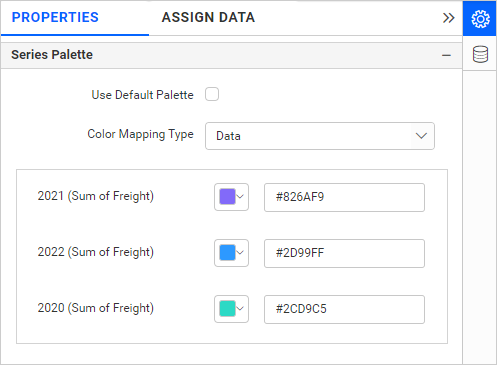
Color Mapping Type
By using the Color Mapping type, you have the ability to apply colors to the series, either based on data or index.
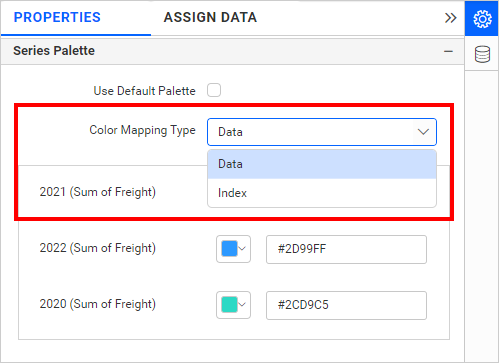
Data
It allows you to apply color to chart series based on data. If you want to assign a specific color to specific data (e.g., Violet for 2021, Sky Blue for 2022, and green for 2020), you can use data-based color mapping. The default Color Mapping Type is Data.
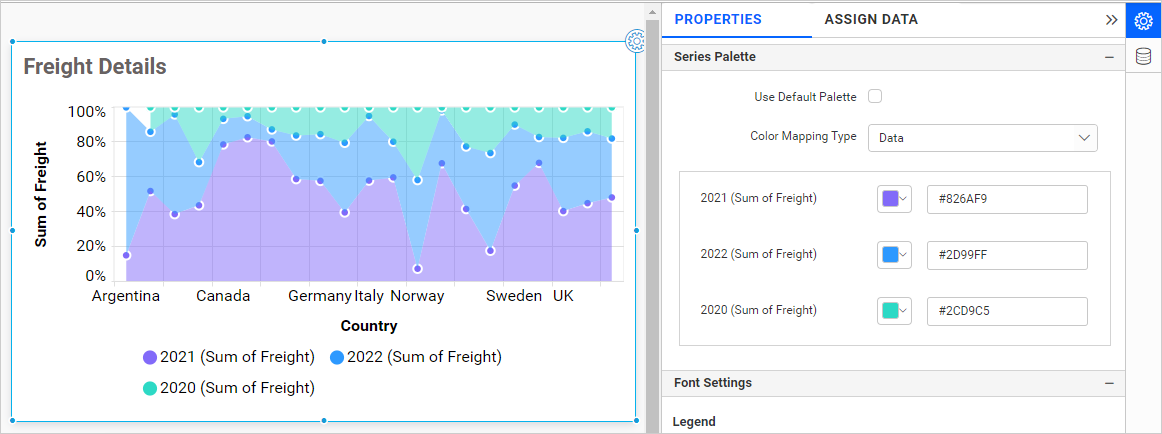
Index
It allows you to apply color to chart series based on the Index, so that the colors remain consistent even if the data is changed. It only shows a maximum of 15 different colors, after which the colors will be repeated from the ones above.
For example, if you are displaying the countries based on the increasing order of the case count, then index-based color mapping will be useful to set the colors based on the rank. For instance, assigning the red color to the top-ranked country will be maintained for the country with the largest case count.
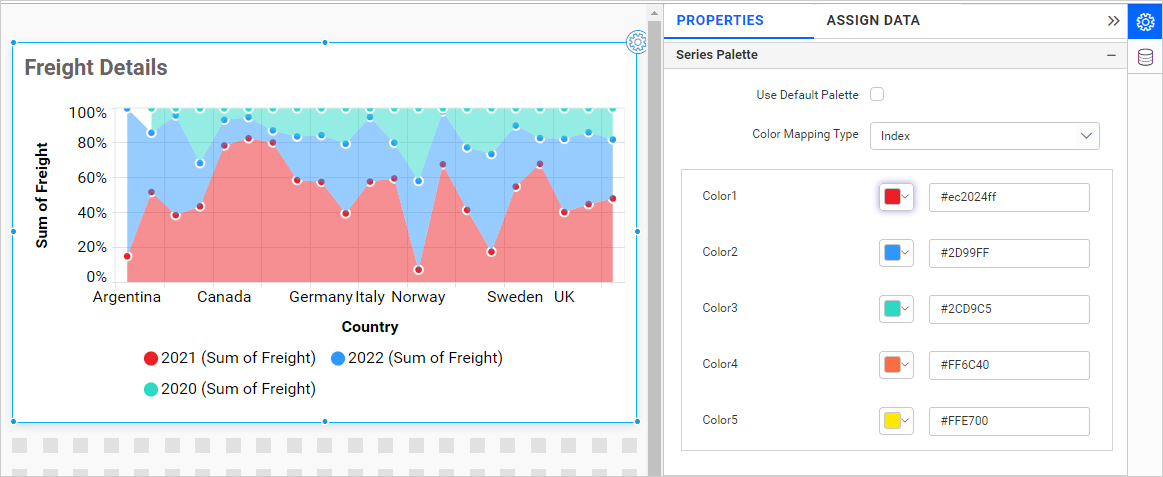
Note: We only prefer to use index-based color customization for a minimum amount of data, up to 15 series.
Font settings
This section allows you to customize the font size of chart elements.

Auto font Size and font size
By default, the Auto Font Size property is enabled. The auto font size property is used to set the font size based on the resolution of the machine on which the dashboard is being viewed. If the user wants to customize or set a fixed font size, they need to disable the auto font size and manually set the desired font size.
Formatting
This feature enables you to personalize the color of the widget.

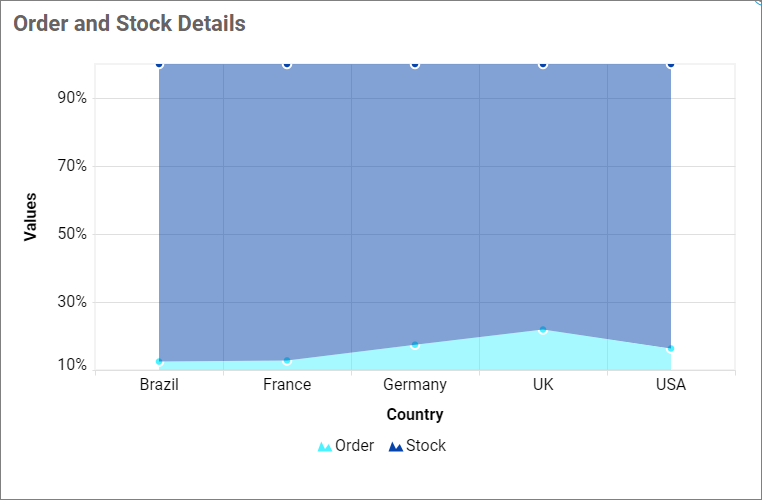
Filter

Act as Master Widget
This allows you to define the 100% stacked area chart widget as a master widget, so that other widgets in the dashboard can listen to its filter action.
Ignore Filter Actions
This feature allows you to define the 100% stacked area chart widget to ignore any filter actions applied to other widgets on the dashboard.
Hierarchical Filter
Through this option, you can enable or disable the hierarchical top N filtering. When applying the Top N filter with multiple dimension columns, the returned data can be customized based on whether the filtering needs to be done as flat or based on the hierarchy of dimension columns added.
When the Hierarchical Filter option is enabled, the Top N will be applied to each individual column separately, based on the number set for each column.
Container Appearance
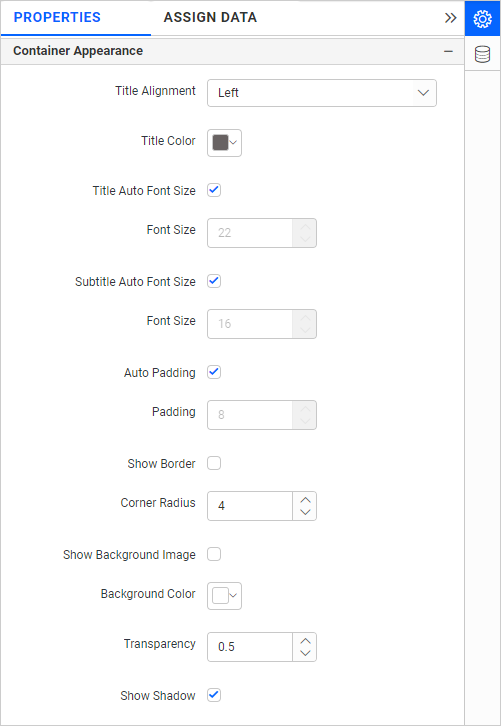
Title Alignment
This feature allows you to adjust the alignment of the widget title to either the left, center, or right.
Title Color
This allows you to apply the text color to the widget title.
Title Auto Font Size
When Auto Font Size is enabled, the title’s font size will be automatically adjusted if the screen resolution varies.
Font Size
This allows you to apply the specified size of the font to the widget title if the Title Auto Font Size is disabled. Value can be between 10 and 44.
Subtitle Auto Font Size
When Auto Font Size is enabled, the subtitle’s font size will be automatically adjusted if the screen resolution varies.
Font Size
This allows you to apply the specified font size to the widget title if the Subtitle Auto Font Size is disabled. The value can be between 10 and 32.
Auto Padding
When Auto Padding is enabled, the padding of the widget container will adjust automatically if the size of the widget varies.
Padding
This allows you to customize the padding of the widget container if the Auto Padding is disabled. The value can be between 0 and 25.
Show Border
This feature allows you to toggle the visibility of the border surrounding the widget.
Corner Radius
This allows you to apply the specified radius to the widget corners if the Show Border is enabled. The value can range from 0 to 10.
Show Background Image
This allows you to set the background image for the spline area chart widget.
Background Color
This feature allows you to set the background color for the spline area chart widget.
Transparency
This property allows you to specify the transparency for the background color.
Show Shadow
This feature allows you to toggle the visibility of the Shadow surrounding the widget.
Container actions
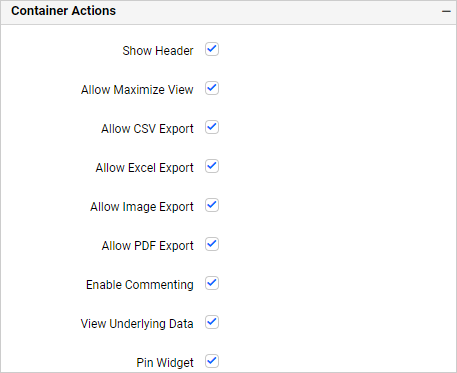
Show Header
This feature allows you to enable or disable the widget title of the 100% stacked area chart.
Allow Maximize View
This allows you to enable or disable the maximized mode of the 100% stacked area chart widget. The visibility of the maximize icon in the widget header will be defined based on the setting in the viewer.
Allow CSV Export
This allows you to enable or disable the CSV export option for the 100% stacked area chart widget. Enabling this allows you to export the summarized data of the widget view to CSV format in the viewer.
Allow Excel Export
This allows you to enable or disable the Excel export option for the 100% stacked area chart widget. Enabling this allows you to export the summarized data of the widget view to (.xlsx or .xls) format in the viewer.
Allow Image Export
This allows you to enable or disable the Image export option for the 100% stacked area chart widget. Enabling this allows you to export the view of the widget to image format (.jpg), (.png), or (.bmp) in the viewer.
Allow PDF Export
This allows you to enable or disable the PDF export option for the 100% stacked area chart widget. Enabling this allows you to export the view of the widget to pdf format in the viewer.
Enable Comments
This allows you to enable or disable comment for the dashboard widget. For more details, refer to the Commenting Widget.
Allow View Underlying Data
This allows you to visualize the raw data associated with a widget at runtime.
To learn more about viewing the underlying widget data, refer to the view data documentation.
Pin Widget
This allows you to pin the widget.
Responsive Behavior
We hide the widget elements based on the widget’s size for better readability.
When the chart has been placed with less than 7 columns chart Y-axis labels, Y-axis titles will be hidden.
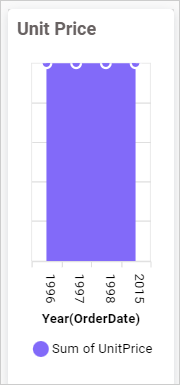
When the chart has fewer than 6 rows, the X-axis labels, X-axis titles, and gridlines will be hidden.
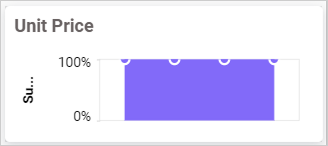
- How to configure the table data to 100 stacked area chart
- Adding Values
- Filtering data
- Formatting data
- Adding Columns
- Renaming fields
- Sorting data
- Filtering data
- Multi-Level Drill Down
- Adding Rows
- Hidden Column
- Linking
- Filtering
- View Data
- How to format 100 stacked area chart
- General Settings
- Name
- Subtitle
- Description
- Basic Settings
- Show Tooltip
- Show Value in Tooltip
- Chart Type and axis
- Enable Animation
- Show Value Labels
- Customize
- Value Label Color
- Value Label Position
- Value Label Rotation
- Value Label Suffix
- Suffix Value
- Show Marker
- Show Items With No Data
- Empty Point Mode
- Gap
- Zero
- Average
- Enable Smooth Scroll
- Page Size
- Legend Settings
- Show Legend
- Legend Interactivity
- Legend Label Color
- Customize
- Legend Position
- Legend Item as Dropdown
- Legend Alignment
- Legend Shape
- Legend Title
- Text Overflow
- Text Width
- Link
- Axis Settings
- Title color
- Label color
- Show Axis Border
- Show Category Axis
- Show Category Axis Title
- Category Axis Title
- Label overflow mode
- Trim Axis Labels
- Label Maximum Width
- Category Axis Label Rotation
- Auto Interval and Interval
- Show Primary Value Axis
- Show Primary Value Axis Title
- Primary Value Axis Title
- Inverse Axis
- Axis Range Settings
- Parameter Support in Axis range
- Single Parameter Value
- Range Parameter Value
- Data Source Field Based Parameter Value
- Grid Line
- Primary value Axis
- Category Axis
- Series Palette
- Use Default Palette
- Color Mapping Type
- Font settings
- Auto font Size and font size
- Formatting
- Filter
- Act as Master Widget
- Ignore Filter Actions
- Hierarchical Filter
- Container Appearance
- Title Alignment
- Title Color
- Title Auto Font Size
- Subtitle Auto Font Size
- Auto Padding
- Show Border
- Corner Radius
- Show Background Image
- Background Color
- Transparency
- Show Shadow
- Container actions
- Show Header
- Allow Maximize View
- Allow CSV Export
- Allow Excel Export
- Allow Image Export
- Allow PDF Export
- Enable Comments
- Allow View Underlying Data
- Pin Widget
- Responsive Behavior
- How to configure the table data to 100 stacked area chart
- Adding Values
- Filtering data
- Formatting data
- Adding Columns
- Renaming fields
- Sorting data
- Filtering data
- Multi-Level Drill Down
- Adding Rows
- Hidden Column
- Linking
- Filtering
- View Data
- How to format 100 stacked area chart
- General Settings
- Name
- Subtitle
- Description
- Basic Settings
- Show Tooltip
- Show Value in Tooltip
- Chart Type and axis
- Enable Animation
- Show Value Labels
- Customize
- Value Label Color
- Value Label Position
- Value Label Rotation
- Value Label Suffix
- Suffix Value
- Show Marker
- Show Items With No Data
- Empty Point Mode
- Gap
- Zero
- Average
- Enable Smooth Scroll
- Page Size
- Legend Settings
- Show Legend
- Legend Interactivity
- Legend Label Color
- Customize
- Legend Position
- Legend Item as Dropdown
- Legend Alignment
- Legend Shape
- Legend Title
- Text Overflow
- Text Width
- Link
- Axis Settings
- Title color
- Label color
- Show Axis Border
- Show Category Axis
- Show Category Axis Title
- Category Axis Title
- Label overflow mode
- Trim Axis Labels
- Label Maximum Width
- Category Axis Label Rotation
- Auto Interval and Interval
- Show Primary Value Axis
- Show Primary Value Axis Title
- Primary Value Axis Title
- Inverse Axis
- Axis Range Settings
- Parameter Support in Axis range
- Single Parameter Value
- Range Parameter Value
- Data Source Field Based Parameter Value
- Grid Line
- Primary value Axis
- Category Axis
- Series Palette
- Use Default Palette
- Color Mapping Type
- Font settings
- Auto font Size and font size
- Formatting
- Filter
- Act as Master Widget
- Ignore Filter Actions
- Hierarchical Filter
- Container Appearance
- Title Alignment
- Title Color
- Title Auto Font Size
- Subtitle Auto Font Size
- Auto Padding
- Show Border
- Corner Radius
- Show Background Image
- Background Color
- Transparency
- Show Shadow
- Container actions
- Show Header
- Allow Maximize View
- Allow CSV Export
- Allow Excel Export
- Allow Image Export
- Allow PDF Export
- Enable Comments
- Allow View Underlying Data
- Pin Widget
- Responsive Behavior